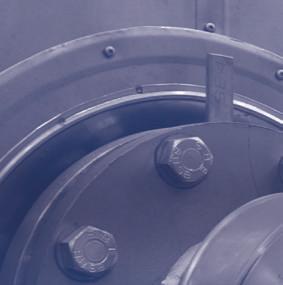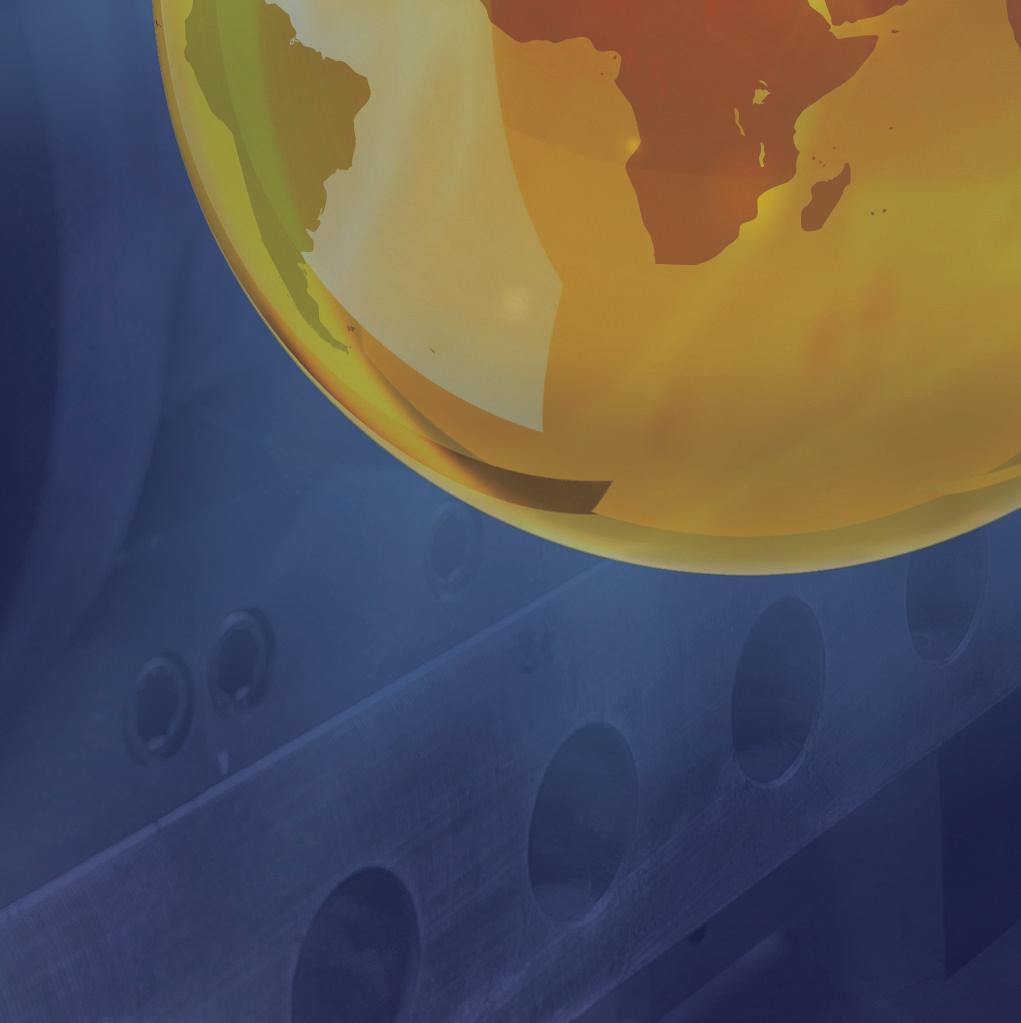






























































































































































































































22 Exports drive flaxseed
One of the leading global flaxseed producers, Kazakhstan is expecting a bumper crop this year following last year’s below average harvest
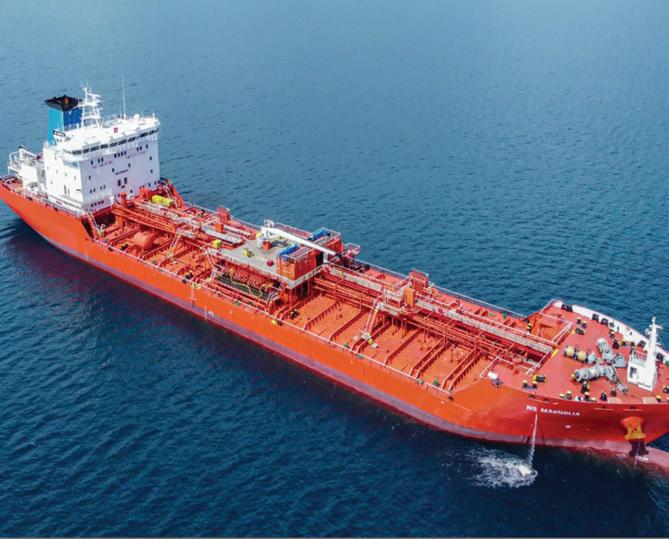
18 Challenges ahead
The onset of UCO exports, an ageing fleet, contraction of tonnage and regulations to cut emissions will all have an impact on the shipping sector
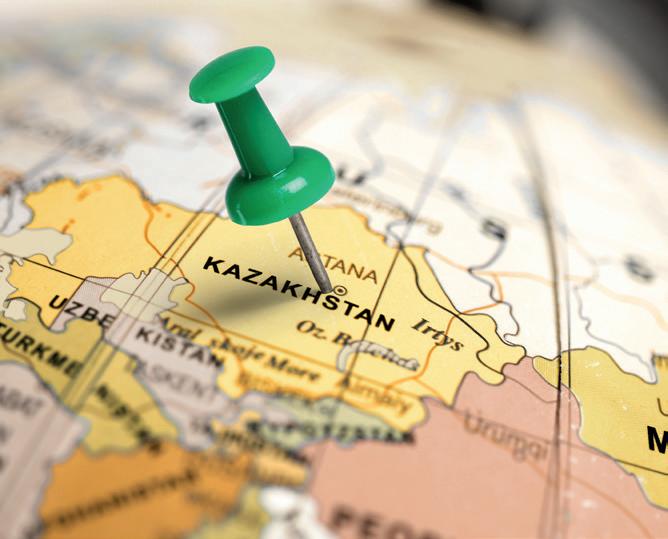
USA, Biodiesel/HVO
28 Impacting global trade
The boom in US renewable diesel production has impacted global trade of soyabean meal, as well as the country’s imports of oils and fats
Standards, Testing & Analysis

33 MOHs update
Mineral oil hydrocarbons (MOHs) are chemical compounds mainly derived from crude petroleum oil which can end up in food during harvesting and production processes, with mineral oil aromatic hydrocarbon (MOAH) being of concern to human health
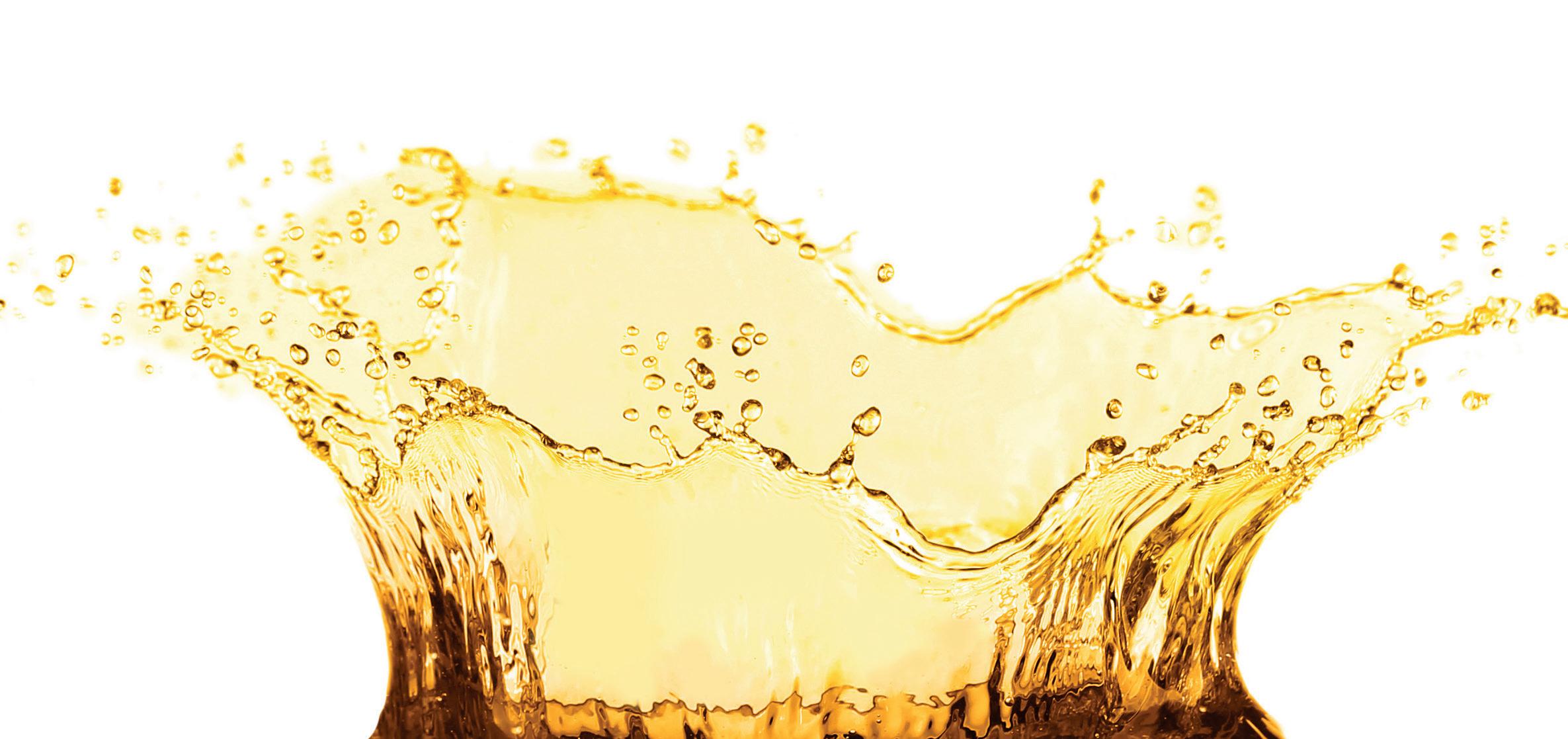
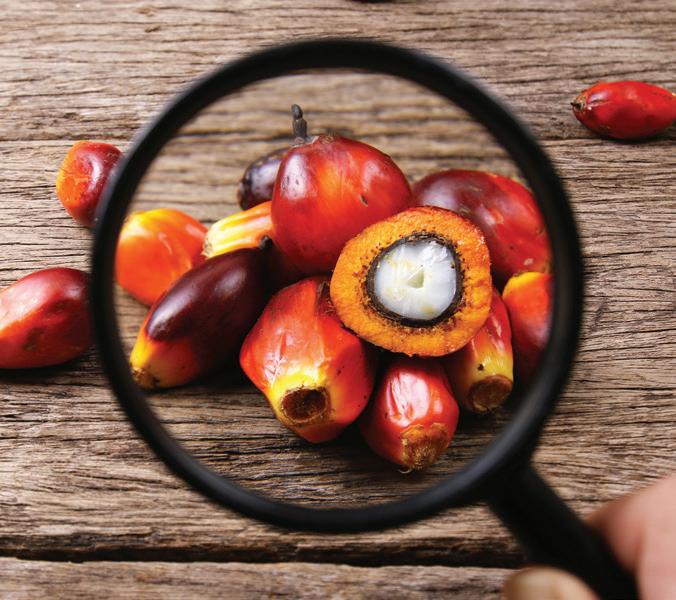
2 What now for EU deforestation law?
4 European Commission proposes delaying EUDR
10 Chinese biodiesel exports to EU fall by 91% in July Renewable News
12 Argent Energy launches glycerine facility
Viterra to acquire five sites from Cargill
16 Food retailers, producers demand GE food labelling
events listing
EDITORIAL:
Editor: Serena Lim serenalim@quartzltd.com +44 1737 855066
Assistant Editor: Gill Langham gilllangham@quartzltd.com +44 1737 855157
ADVERTISING:
Mark Winthrop-Wallace markww@quartzltd.com +44 1737 855114
PRODUCTION:
Production Editor: Carol Baird carolbaird@quartzltd.com
CORPORATE:
Managing Director: Tony Crinion tonycrinion@quartzltd.com +44 1737 855164
SUBSCRIPTIONS: Jack Homewood subscriptions@quartzltd.com +44 1737 855028
Subscriptions, Quartz House, 20 Clarendon Road, Redhill, Surrey RH1 1QX, UK
SUBSCRIPTION RATES:
Print & digital: Single issue – £45
1 year – £182 (UK), £210 (overseas)
2 years – £328 (UK), £377 (overseas)
3 years – £383 (UK), £440 (overseas)
Digital only: Single issue – £29
1 year – £170
2 years – £272
3 years – £357

© 2024, Quartz Business Media ISSN 0267-8853
WWW.OFIMAGAZINE.COM

A member of FOSFA
Oils & Fats International (USPS No: 020747) is published eight times/year by Quartz Business Media Ltd and distributed in the USA by DSW, 75 Aberdeen Road, Emigsville PA 17318-0437. Periodicals postage paid at Emigsville, PA. POSTMASTER: Send address changes to Oils & Fats c/o PO Box 437, Emigsville, PA 17318-0437
Published by Quartz Business Media Ltd Quartz House, 20 Clarendon Road, Redhill, Surrey RH1 1QX, UK oilsandfats@quartzltd.com +44 1737 855000
Printed by Pensord Press, Merthyr Tydfil, Wales

Just three months before the landmark EU Deforestation Regulation (EUDR) was due to come into force, the European Commission (EC) has proposed delaying its implementation for a year.
The move announced on 2 October (see p4) has been met with dismay by environmentalists and companies which have invested heavily in being compliant on time, but has been welcomed by some business and farming lobbies, key EU trading partners such as the USA and Brazil, and top palm oil producers Indonesia and Malaysia.
Adopted in December 2022 with the noble aim of tackling the EU’s contribution to deforestation, the EUDR requires companies selling or exporting seven commodities in the EU (cocoa, coffee, palm oil, soyabean, cattle, rubber and timber) to ensure they are deforestation-free and legally sourced.
Companies would have faced significant fines (40% of their EU turnover) if they were not compliant by 30 December. And some have invested heavily in being ready on time. “Those companies will inevitably suffer losses in their investments,” says the EU vegetable oils and protein meal industry association FEDIOL.
A major problem with the EUDR has been a lack of clarity relating to compliance, with the EC only producing its ‘additional guidance’ when it announced the EUDR delay.
“It’s inexcusable that the Commission took so long to issue the supporting documents for the implementation of the law,” said Sébastien Risso, Greenpeace forest policy director.
The EUDR requires huge amounts of data to be collected by all players in the supply chain to carry out due diligence and assess deforestation risk. This includes geolocation and polygon mapping data of where the commodities have been produced, and documents to prove legal compliance with land use and human rights, as well as tax, anti-corruption, trade and customs regulations. One product could have hundreds of due diligence statements that need to be searchable, tied together and shared with customers and traders, all to be submitted onto an Information System with a file size limit of 25MB.
It’s clear that some businesses and countries were not ready. But for the companies that have invested to be ready, the delay is an unfair penalty.
The larger question is whether the EUDR will actually come into force in a year’s time as it stands. Many of those who pushed for the postponement want to abandon the EUDR altogether. It was the conservative European Peoples’ Party – the largest group in the European Parliament – which launched a concerted push for a delay immediately after the EU elections in June, with support from political groups further to the right, according to a euronews article.
The European Commission has stressed that the delay does not change the aim and substance of the EUDR. But there will be fears that this delay may indicate a weakening of the EU’s resolve to tackle agricultural deforestation.
Serena Lim, serenalim@quartzltd.com
UKRAINE: A Russian missile struck a grain ship docked at Ukraine’s Port of Odessa, killing one person and injuring five crew members, Reuters reported on 8 October.
The strike on 7 October followed an attack the previous day on a vessel carrying 6,000 tonnes of corn at the nearby Port of Pivdennyi. No injuries were reported in the earlier strike but the grain ship was severely damaged, the report said.
The ship which struck at the Port of Odessa was the 21st civilian vessel to be damaged by Russian missile strikes since the conflict began in February 2022, Reuters said.
Despite the attacks, Ukraine’s agriculture ministry said on 7 October that the country had exported 11.2M tonnes of grain since the start of the 2024/25 marketing year in July compared to 7.2M tonnes in the same period the previous year.
WORLD: The practice of discharging waste palm oil into the sea may be included in a revised sustainability standard to be drafted by the Roundtable on Sustainable Palm Oil (RSPO) next year, Eco-Business reported on 14 August.
The RSPO’s statement followed two recent incidents of palm oil dumping reported off the coast of Malaysia. Although banned in European waters, palm oil discharging was still legally permissible under international pollution regulations in certain conditions, Eco-Business wrote.
The International Maritime Organization (IMO) said waste reception facilities at ports were crucial for avoiding waste dumping by ships at sea but such facilities were often lacking in Southeast Asia, and ships sometimes discharged palm oil residues at sea to avoid paying to use waste reception facilities.
The European Commission (EC) has proposed delaying the EU Deforestation Regulation (EUDR) by 12 months following lobbying by companies and governments around the world.
Originally due to take effect on 30 December, the regulation will ban the sale in the EU of seven commodities linked to deforestation - palm oil, soyabean, timber, rubber, coffee, cocoa and cattle. The delay must be approved by EU ministers and the European parliament to take effect.
If approved, the regulation would come into force on 30 December 2025 for large companies and 30 June 2026 for small enterprises.
In a statement on its website on 2 October, the EC said the extra 12 months could serve as a phasing-in period to ensure proper and effective implementation.
“The Commission recognises that three months ahead of the intended implementation date, several global partners have repeatedly expressed concerns about their state of preparedness,” the statement said. “The state of preparations amongst stakeholders in Europe is also uneven. While many expect to be ready in time ... others have expressed concerns.”
The EC added that the extension proposal did not change the objectives or the substance of
the law, as agreed by EU co-legislators.
At the same time as announcing the proposed delay, the EC published additional guidance to help ensure uniform interpretation of the law covering a range of issues such as legality requirements, the application time frame, agricultural use and clarifications on the product scope.
The EC also published the principles of the methodology it would apply to the EUDR benchmarking exercise, serving to classify countries as low, standard or high risk.
“Following the methodology applied, a large majority of countries worldwide will be classified as ‘low risk’,” the EC said.
The information system where businesses would register their due diligence statements would be ready to start accepting registrations in early November, the EC said. Due diligence statements could be submitted before the law’s entry into force.
The EC said it would also present a strategic framework for international co-operation engagement on the EUDR and had identified five priority areas of action such as support to smallholders, eight key principles such as a human rights-centred approach and several implementation tools including dialogue and financing.
SD Guthrie International (SDGI), formerly known as Sime Darby Plantation (SD Plantation), announced on 19 September that it had delivered its first shipment of palm oil compliant with the EU Deforestation Regulation (EUDR).
In its first delivery, 24,250 tonnes of palm oil arrived at SDGI’s Zwijndrecht Refinery in the Netherlands a week prior to the report and a second shipment of 16,000 tonnes arrived at SDGI’s Liverpool Refinery in the UK on the day of the announcement. The palm oil was sourced from 102,337ha of oil palm plantations and smallholder farms.
To achieve EUDR compliance, SDGI said it worked closely with SD Guthrie’s upstream division to ensure detailed polygon maps and deforestation-free assessments of all plantations were

available. By using satellite imagery and partnering with a third-party verifier, SD Guthrie said it had been able to assess a forest baseline covering 6bn ha and had analysed around 600,000ha of its plantations for deforestation risks.
This work was supported by audit reports that also documented adherence to national legislation, International Labour Organisation (ILO) standards
and respect for native customary rights, SDGI said.
As part of its No Deforestation, No Peat and No Exploitation policy introduced in 2016, SDGI had been using Crosscheck since 2019, an online traceability tool mapping its palm oil from source to supply, SDGI said. The tool allowed traders and buyers to pinpoint issues in the supply chain and raise alerts for necessary action.

Unleash the power of reliability when you partner with CPM’s Crown. As the world leader in oilseed processing solutions, our equipment is backed by proven technology, superior design and more than a century of engineering expertise. Test and verify product and process feasibility at our Global Innovation Center: a fully functional pilot plant, analytical lab and training facility that helps you discover how to minimize downtime and overcome inef ciencies. By partnering with Crown, you will consistently honor customer commitments with more con dence and control. And, from risk management to environmental management, Crown applies a global lens to your operations. Count on our problem-solving expertise to help ful ll your sustainability commitments. Superior equipment. Unparalleled support. Every step of the way.






INDONESIA: Palm oil exports are expected to fall by 2M tonnes this year to 30.2M tonnes due to increased domestic consumption and reduced output, a 19 September Reuters article quoted Fadhil Hasan of the Indonesian Palm Oil Association as saying.
Production was expected to drop by 1M tonnes to 53.8M tonnes in 2024 as last year’s dry weather had lowered yields, he added.
Indonesia increased its palm oil biodiesel blending mandate to 35% in 2023, lifting domestic palm oil consumption from 23.2M tonnes to a record expected 24.2M tonnes in 2024.
In August, Indonesia’s energy ministry announced plans to raise the biodiesel blending rate to 40% in January 2025.
ARGENTINA: Global agribusiness giant Louis Dreyfus Company (LDC) announced on 9 August that it had launched a regenerative agriculture programme in Argentina aimed at bringing together agricultural stakeholders to help reduce carbon emissions, conserve natural ecosystems and resources, and boost climate resilience in farming communities. Focusing on soyabeans, corn and camelina crops, the programme aimed to cover 205,000ha and would involve 400 farmers in the country by 2030.
The Chinese government has announced an anti-dumping investigation into Canadian canola imports, RealAgriculture reported on 3 September.
The move was part of a series of actions announced by the Chinese government in response to the Canadian government’s plan to introduce a 100% tax on Chinese electric vehicle (EV) imports and a 25% tax on Chinese steel and aluminium.
China had previously banned canola imports from Canada’s two largest exporters Richardson and Vittera – from March 2019 to May 2022 –following Canada’s arrest of Huawei executive Meng Wanzhou on an extradition request by the USA, RealAgriculture wrote.
The Chinese Ministry of Commerce was quoted as saying it was launching the anti-dumping investigation to safeguard domestic businesses following a 170% rise in Canadian canola seed
imports in 2023, the first full year after the lifting of the embargo.
The Canola Council of Canada (CCC) was working closely with the Canadian government while waiting for further details on the investigation, the report said. “We are confident that an investigation into Canada’s canola trade with China will demonstrate alignment with, and reinforce our support for, rules-based trade.” CCC president and CEO Chris Davison was quoted as saying.
According to Statistics Canada, exports of canola seed to China in the 2023 calendar year totalled almost 4.6M tonnes, up from 2.2M tonnes in 2022 but below the 4.8M tonnes shipped in 2018, prior to the last canola trade disruption with China. In the first six months of this year, 2.7M tonnes of canola seed were shipped from Canada to China.
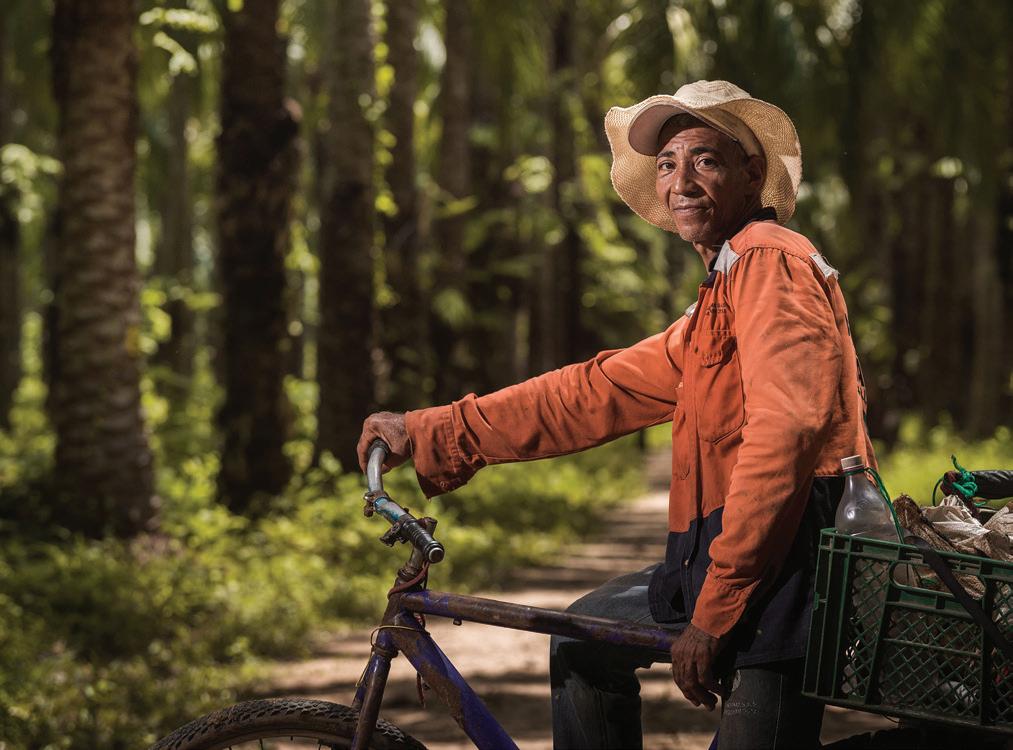
Daabon UK, part of the Daabon Group, has launched a carbon-neutral organic palm oil
range produced at its CI Tequendama SAS mill in northern Colombia (pictured), the
company said on 4 October.
“Our next step is to replicate this at our other refinery, with the eventual goal of making all the palm oil we offer become carbon-negative and climate-positive,” Manuel Davila, managing director of Daabon UK and the EU, said. “Of course, there is still some way to go to cut the emissions associated with onward transport and global shipping.”
Daabon has committed to having net zero carbon emissions by 2040.
As well as palm oil, the family-owned Daabon Group also produces avocados, bananas, cocoa, coffee and limes.
Olive trees in Italy’s major olive-growing regions have been damaged by heatwaves and severe drought conditions ahead of this year’s harvest, Olive Oil Times wrote.
The damage was expected to lead to production dropping to historic lows this year, the 9 August report said.
Southern regions in the country, responsible for most Italian olive oil production, had been the most impacted by the harsh weather conditions, Olive Oil Times said.
Numerous rain-fed olive trees in Puglia, for example, were showing signs of water
stress, with many olives desiccating on branches, the report said.
“Severe and prolonged drought is compelling farmers to undertake emergency irrigation at exorbitant costs, driven by the high fuel prices needed to extract water from wells and transport it via tankers,” farmers’ association Coldiretti Puglia said.
“We have already lost the entire olive production for the current season,” added Paolo Colonna, president of olive producers’ association Oprol.
“If these weather conditions persist, next
season’s production could also be at risk.”
Slightly less severe drought and temperature conditions had also affected central olive growing regions, including Lazio and Umbria, Olive Oil Times wrote.
Olive growers’ association Italia Olivicola had forecast that the ‘off-year’, combined with extreme weather conditions, would reduce Italian olive oil production by at least 23% compared to the previous season.
According to EU estimates, Italy produced 328,000 tonnes of olive oil in the 2023/24 crop year.
The Indian government has raised customs duty on edible oils in a bid to support oilseed farmers, Reuters wrote.
Effective from 14 September, a 20% basic customs duty on crude palm oil, crude soyabean oil and crude sunflower oil was introduced, the finance ministry’s notification on the same date said.
As the three oils were also subject to India’s Agriculture Infrastructure and Development Cess and Social Welfare Surcharge, the move would effectively increase the total import duty on the three oils from 5.5% to 27.5%.
Malaysian oil palm company Kuala Lumpur Kepong (KLK) has formed a joint venture with vegetable oil product and consumer goods firm Alami Commodities to manufacture, market and sell palm oil and speciality fats in the Middle East.
Trading as KLK Alami Edible Oils (KAEO), the joint venture would operate a refinery and packaging plant in Selangor, Malaysia, scheduled to be commissioned in 2025, the companies said in a joint statement on 25 September.
KLK would own 65% of KAEO and oversee all technical operations, including the sourcing of raw materials, while Alami would hold the remaining share and manage global sales and marketing efforts “with a focus on the Middle East”.
Established as a plantation company more than 100 years ago, KLK is focused on oil palm development and had about 300,000ha of planted area across Malaysia (Peninsular and Sabah), Indonesia (Belitung Island, Sumatra, as well as Central and East Kalimantan) and Liberia, as of September 2022.
The group has oleochemical and refinery operations in Malaysia, Indonesia, China, Switzerland, Germany, the Netherlands, Belgium and Italy.
Part of the Alami Group of companies, Alami Commodities exports vegetable oil derivatives and downstream products to more than 60 global destinations.
The import tax on imports of refined palm, soyabean and sunflower oils increased from 13.75% to 35.75%.
The move could raise edible oil prices and dampen demand, leading to a reduction in imports of the three oils, the report said.
In August, Reuters reported India was looking into increasing import taxes on vegetable oils to help domestic soyabean growers ahead of regional elections due in Maharashtra later this year.
“After a long time, the government has been attempting to balance the interests
of both consumers and farmers,” Sandeep Bajoria, CEO of vegetable oil brokerage Sunvin Group, was quoted as saying.
The move had increased the likelihood of farmers receiving the minimum support price set by the government for their soyabean and rapeseed harvests, Bajoria said.
According to the report, India meets more than 70% of its vegetable oil demand through imports, buying palm oil mainly from Indonesia, Malaysia and Thailand, while it imports soyabean oil and sunflower oil from Argentina, Brazil, Russia and Ukraine.




INDIA: The government has launched two missions to boost edible and palm oil production in a bid to ensure food security and end its reliance on imports, Policy Circle wrote on 7 October.
As part of the National Mission of Edible Oils – Oil Palm (NMEO-OP) initiative, seed gardens and oil palm nurseries would be set up to ensure the domestic availability of seedlings. The mission would run from 2024/25 to 2030/31.
Under the national oilseeds scheme, the government planned to increase oilseeds production from 39M tonnes of oilseeds in 2022/23, to 69.7M tonnes by 2030-31, Policy Circle wrote. It also aimed to raise domestic edible oil production from 12.7M tonnes in 2022/23 to 20.2M tonnes in 2030/31.
The report said India imported around 9M tonnes/ year of palm oil, around 56% of total edible oil imports, but the schemes aimed to reduce this to some 28% over the next seven years.
To curb imports, the focus would be on boosting the production of key crops such as mustard, groundnut, soyabean, sunflower and sesame and to increase oil extraction from secondary sources like cottonseed, rice bran and tree-borne oils.
In addition, the government would support the development of high-quality seeds using global technologies such as genome editing, the report said.
US farmers were reeling from the impact of Hurricane Helene on crops as Florida continued to assess the damage caused by Hurricane Milton, Fox5 reported on 9 October.
Hurricane Milton, a category 3 storm, hit Florida on 9 October, causing extensive property damage and leaving millions of homes and businesses without power, The Guardian wrote on 10 November. At the time of the report, the death toll from Milton had reached at least 10.
Milton came just two weeks after Hurricane Helene slammed into Florida’s Gulf coast on 26 September – dumping unprecedented amounts of rain in Georgia, the Carolinas, Tennessee, Virginia and Kentucky – and killing at least 232 people.
The US Department of Agriculture had deployed surge teams to assist with recovery efforts to help with the billions of dollars wreaked on US crops and farmland, Agriculture
Dive wrote on 7 October.
Hurricane Helene had destroyed large portions of Georgia’s cotton, peanut and pecan crops, causing significant losses across the state, Fox5 said. Nearly 30% of the peanut crop had been destroyed and one-third of the state’s cotton crop was considered a total loss, the Georgia Department of Agriculture said.
In North Carolina, damage from Hurricane Helene was expected to be “major”, said Andrea Ashby, director of public affairs for North Carolina Department of Agriculture and Consumer Services. Some of the key commodities affected included corn, soyabean, tobacco and cotton.
Soyabean farmers in North Carolina were facing a range of issues including flooded fields and sprouting in pods causing a decline in seed quality, said North Carolina State University soyabean specialist Rachel Vann.

The Malaysian government has announced a revised adopt-anorangutan plan for major palm oil trading partners, Reuters reported Minister of Plantation Industries and Commodities
Johari Abdul Ghani as saying on 18 August.
Companies that imported Malaysian palm oil would be able to adopt orangutans but the apes would not leave the country. In May, the minister had put forward a plan to
send orangutans overseas as trading gifts but conservation groups had raised concerns over the orangutans' welfare.
Johari said funds raised from companies which adopted orangutans would be distributed to NGOs and the Sabah government to monitor forested areas where the primates lived, and their safety and condition.
Orangutans are found only in the rainforests of the Southeast Asian islands of Borneo and Sumatra and are a critically endangered species due to deforestation of their natural habitat. World Wide Fund for Nature (WWF), said the orangutan population on the island of Borneo was less than 105,000.
China is expected to increase oilseed crushing in 2024/25 due to a moderate rise in demand for protein meals from the feed sector, according to US Department of Agriculture (USDA) data reported by World Grain on 9 September.
Total oilseed crushing was forecast at 137.3M tonnes in 2024/25, up from an estimated 135.3M tonnes the previous year.
Overall feed consumption continued to grow, driving soyabean meal use, the USDA’s Foreign Agricultural Service (FAS) report said. “Additionally, a moderate recovery of vegetable oil demand and greater soyabean use for food also drove up consumption of oilseeds,” the FAS said.
Soyabean crushing was estimated at 99M tonnes in 2024/25, up from 97.5M
tonnes the previous year. Meal consumption for feed in 2024/25 was estimated at 102.7M tonnes, a moderate growth from the 101.3M tonnes the previous year.
Soyabean meal was forecast to account for over 74% of meal consumption.
Total vegetable oil for food use in 2024/25 was also forecast to rise, up from 35.1M tonnes the previous year.















USA: The US Environmental Protection Agency (EPA) has launched investigations into the supply chains of at least two renewable fuel producers amid concerns that some may be using fraudulent feedstocks for biodiesel in a bid to secure government subsidies.
EPA spokesperson Jeffrey Landis told Reuters that the agency had launched audits over the past year but declined to identify the companies involved as the investigations were ongoing.
Under the EPA-administered Renewable Fuel Standard (RFS) programme, refiners can earn a range of state and federal environmental and climate subsidies, including tradable credits.
However, following a surge in used cooking oil (UCO) exports from Asia – involving high volumes relative to the amount of cooking oil used and recovered in the region – concerns had been raised that some supplies labelled as UCO might be cheaper and less sustainable virgin palm oil, the 7 August report said.
The European Union was also investigating the alleged use of fraudulent feedstocks, Reuters wrote.
The EPA audits began after the agency updated domestic supply-chain accounting requirements in July 2023 for renewable fuel producers seeking to earn credits under the RFS.
European Union (EU) imports of biodiesel from China fell by 91% in July compared to the previous month following the European Commission (EC)’s introduction of anti-dumping duties, according to Eurostat data reported by Palm Oil Magazine
Chinese biodiesel exports to the EU dropped from 109,457 tonnes in June to 9,835 tonnes in July – the lowest level since April 2021, according to the analysis. In July, the EU
imposed temporary anti-dumping duties ranging from 12.8% to 36.4% on biodiesel and hydrotreated vegetable oil (HVO) imports from China, the 27 September report said citing Quantum Commodity Intelligence data.
However, China’s export data did not correspond with EU import figures, with China reporting exports of 74,343 tonnes in May and 43,412 tonnes in June, Palm Oil Magazine wrote.
The discrepancies had raised concerns about potential gaps in sustainable certification, which traders claimed could be used to bypass anti-dumping duties, the report said.
European Biodiesel Board (EBB) general secretary Xavier Noyon welcomed the import data saying it showed the duties were delivering relief for EU industries.
“But the potential to avoid duties would still be our concern,” he added.
The International Air Transport Association (IATA) has announced it will be launching a Matchmaker Platform to link airlines and sustainable aviation fuel (SAF) suppliers.
Announcing the initiative on 24 September at the World Sustainability Symposium held in Miami, USA, IATA said the initiative was scheduled for launch in the first quarter of next year.
“Our vision is to create a transparent, efficient and accessible matchmaking platform that will accelerate the uptake of SAF as the aviation industry progresses towards net zero CO₂ emissions by 2050,” IATA’s senior vice president of Sustainability and chief economist Marie Owens Thomsen said.
IATA said the SAF Matchmaker Platform would cover three specific areas – connectivity, visibility and efficiency.
SAF producers and suppliers would be able to post available or planned SAF volumes and airlines would be able to register their interest in purchasing shown or desired SAF volumes. Any subsequent trade would take place outside the platform. The platform would also provide information on available SAF including volumes,
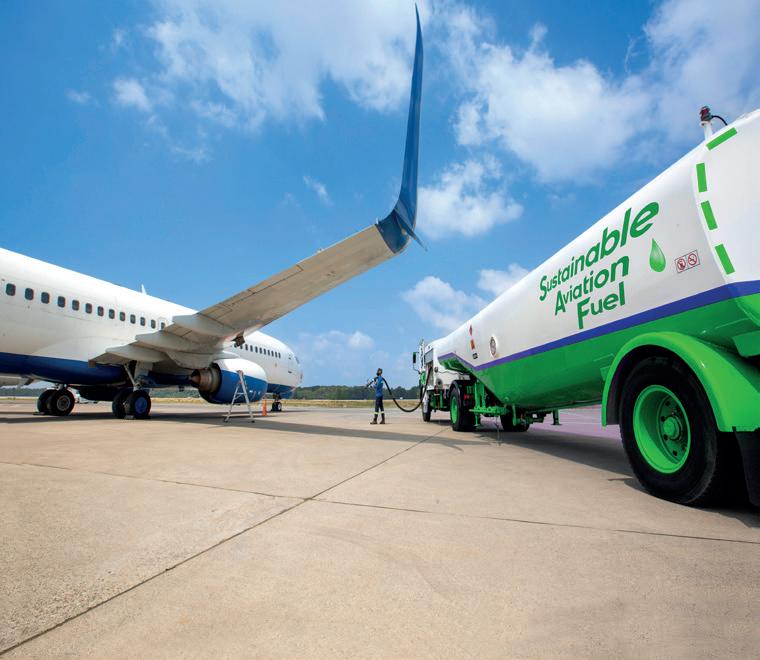
feedstock used, the location and technology of production, emission reductions, as well as compliance with the Carbon Offsetting Reduction Scheme for International Aviation (CORSIA) or the EU’s Renewable Energy Directive (EU RED). IATA said the central platform would simplify SAF procurement by making it easier and faster for all parties to connect.
US oilseed associations have welcomed a bill to support the production of renewable fuels from domestically-sourced feedstocks.
The National Oilseed Processors Association (NOPA) and the American Soybean Association (ASA) welcomed the move in an announcement on 24 September.
In addition to restricting eligibility for the Section 45Z Clean Fuel Production Tax Credit to fuels produced from domestic
feedstocks, the Farmer First Fuel Incentives Act would make the tax credit a 10-year credit by extending it to 2034.
“NOPA commends this bipartisan, bicameral legislative effort which puts US fuel producers, US crushers and US farmers first,” NOPA president and CEO Kailee Tkacz Buller said.
“We support free trade and open markets, but do not believe foreign feedstocks should benefit on the backs of US taxpay-
ers to the detriment of US farmers. Without this fix, the 45Z credit will incentivise the use of foreign feedstocks over those grown by US farmers. Our industry has made significant investments to expand US crushing capacity by 30% and this fix is pivotal to ensuring these investments are delivered.”
ASA president Josh Gackle said US farmers needed the support of a final 45Z rule prioritising domestically-sourced feedstock.
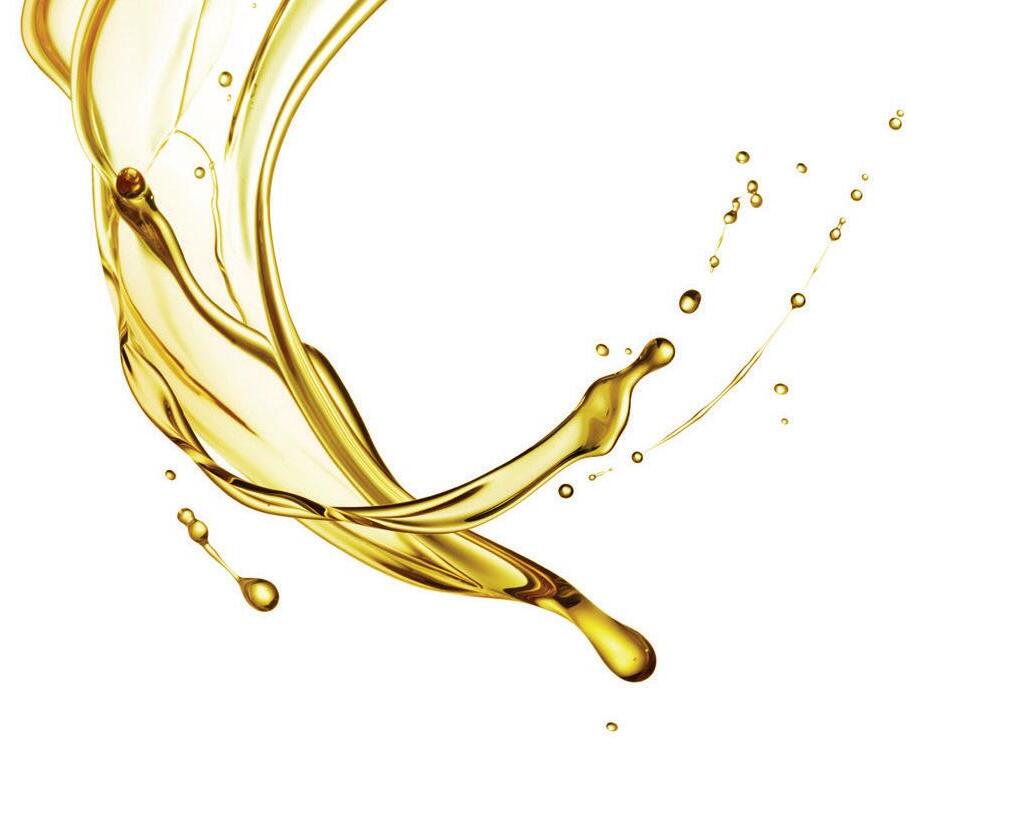




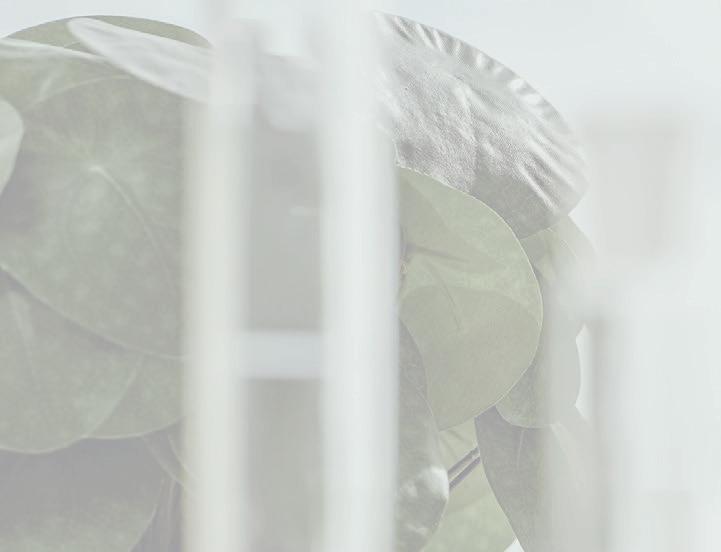












t
t.
w.
e
Leading European biofuels manufacturer Argent Energy has launched a glycerine facility at its Port of Amsterdam site in the Netherlands.
The 50,000 tonnes/year refinery will upgrade crude glycerine – a by-product of Argent’s waste-based biodiesel process –into 99.7% technical-grade glycerine, the company said on 1 October.
“By upgrading glycerine from our processes into a technical-grade prod-
JAPAN: A research team at Osaka Metropolitan University has developed a new catalyst that converts a glycerol derivative into bio-based propylene, the American Association for the Advancement of Science reported on 24 September on its EurekAlert website. Typically produced from petroleum, propylene is used in the manufacture of plastics, such as car bumpers and food containers.
The research from the Graduate School of Science developed a catalyst that selectively breaks down the oxygen-carbon bond in allyl alcohol, a derivative of glycerol, the report said.
The catalyst contained a special molecule, known as a metalloligand, which was designed to facilitate the reversible binding of two metals within the catalyst. This feature enhanced the reaction’s efficiency, providing high selectivity and minimising the formation of byproducts.
uct, we’re giving the chemical industry a bio-based option they can … use in their own products,” Argent Energy CEO Louise Calviou said.
The refined glycerine could be used to produce ethylene glycol or propylene glycol, which act as anti-freezing agents, the company said.
It can also be used as a plasticiser agent in the production of polymers, such as plastics and foams; and is suitable for use
in the production of epichlorohydrin, a key component in the creation of epoxy resins; and other applications.
Argent Energy, which currently produces over 190,000 tonnes/year of wastebased biodiesel for use in road transport, marine and power generation, said its aim to scale up its operations and decarbonisation efforts included plans to triple biofuel production at its Amsterdam site.
Global bio-polymer producer Braskem SA has launched a bio-polypropylene (bio-PP) product produced from used cooking oil (UCO).
Sold under the brand name WENEW, the product was aimed at the restaurant and snack food industries, Braskem said on 16 September.
“Our bio-circular PP is currently being supplied to various converters which support the Quick Service Restaurant (QSR) industry. Ideal users include QSR chains, retail food suppliers, traditional restaurants and snack food companies, especially those seeking to enhance circularity from their cooking oil usage,” Braskem America Polyolefins vice president Bill Diebold said.
The bio-PP was suitable for a range of applications, including food packaging, flexible packaging (such as films) and consumer goods, Diebold said.
Braskem said it had partnered with several suppliers in the value chain who, through their production facilities, converted bio-circular feedstock

into polypropylene, creating a sustainable loop.
The company has set out a plan to reduce scope 1 and 2 greenhouse gas emissions by 15% by 2030 and to achieve carbon neutrality by 2050.
Founded in 2002, Braskem is a Brazilian petrochemical company and a leading global producer of thermoplastic resins. Active in more than 71 countries, the company has
Estonian startup company Äio has secured US$6.8M to build a fermentation facility to produce food-grade fats and oils from forestry waste, Green Queen wrote on 27 September.
Although the new facility’s location had not been finalised, the company was aiming for completion by 2026.
Äio uses specialised yeast to turn byproducts from the wood and agricultural industries – like sugars extracted from
sawdust – into food-grade fats and oils.
Using a ‘red yeast’ microbe created and patented by Bonturi, the industrial byproducts were fermented in a process similar to brewing beer, Green Queen wrote. The resulting fats were rich in essential fatty acids and antioxidants, according to Bonturi.
To date, the company had developed three fats: encapsulated oil as an alternative to palm oil in the food industry; buttery fat as a substitute for animal fats,
business units in Brazil, Mexico, the USA, Asia and Europe. With a portfolio of petrochemicals and thermoplastics, including polyethylene (PE), green polyethylene (biopolymer), polypropylene (PP) and PVC, the company’s products are used in the food packaging, home furniture, industrial and automobile components, and paints and coatings sectors.
shortening and coconut oil; and RedOil as an alternative to fish oil and seed oils, which could be used in cosmetic and household products.
The company had also attracted interest from major food, cosmetics and household consumer packaged goods companies, which had agreed to co-develop products, the Green Queen report said.
The alternative fat market was projected to reach US$4.5bn by 2032, the report said.


























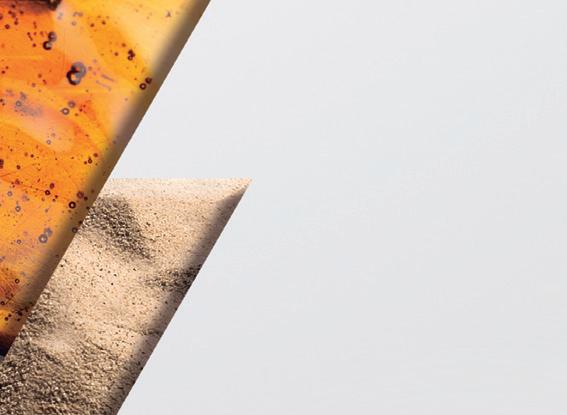




Toymaker Lego has announced plans to make half the plastic in its toy building bricks from renewable materials by 2026, The Guardian reported.
Last year, the Danish company halted plans to make bricks entirely from recycled bottles due to cost and production issues, the 28 August report said.
The company has been testing more than 600 alternative materials as part of its long-term plan to switch entirely to renewable and recycled plastic by 2032, according to the report.
As part of that aim, the company planned to gradually reduce the amount of fossil oil-based plastic it used by paying up to 70% more for certified renewable resin – the raw plastic used to make its bricks – in a bid to encourage manufacturers to increase production, the report said.
Lego’s plastic producers are replacing fossil fuels with alternatives such as cooking oil or food industry waste fat, as well as recycled materials, but costs can be two or three times higher as the market is still developing, according to the report.
Niels Christiansen, the chief executive of Lego, was quoted as saying the shift towards more sustainable materials would lead to a significant increase in the cost of producing its bricks.
Last year, the group committed to triple spending on sustainability to 3bn Danish kroner (US$444M)/year by 2025, without passing on higher costs to consumers.
“So far, we have decided that we will bear the burden of it, and [the extra cost] comes out of our bottom line,” Christiansen said.








Canadian grain handling business Viterra said on 23 September that it had agreed to buy five sites in Australia from global agribusiness giant Cargill.
Viterra would acquire Cargill’s GrainFlow storage and handling facilities in Maitland, Crystal Brook, Mallala and Pinnaroo in South Australia; and Dimboola in Victoria, along with a mobile ship loader in Adelaide, South Australia. GrainFlow operates a network of 16 grain and oilseed storage centres in the states of Queensland, New South Wales, Victoria and South Australia.
In addition, Viterra said it had plans
CANADA: Canadian agribusiness Parrish & Heimbecker (P&H) has partnered with Picton Terminals by Doornekamp to build a new bulk agricultural marine terminal in Prince Edward County, Ontario.
The new facility would increase delivery options available to corn, soyabean and wheat producers in eastern Ontario, the companies said on 15 August.
In addition to significantly reducing travel time for local farmers, easing traffic on Highway 401 and improving the overall efficiency of the agricultural supply chain, the new facility would expand P&H’s export capacity, the companies said.
The construction of storage silos and related buildings was due to start later this year with the terminal expected to be operational by 2026.
P&H’s operations include grain handling and merchandising, flour milling, crop inputs and feed mills.
P&H has 40 grain storage facilities with 23.4M bushels of licensed storage, according to Sosland Publishing Co’s 2024 Grain & Milling Annual
Picton Terminals by Doornekamp provides logistics and port services in the St Lawrence Seaway & Great Lakes region.
to make significant initial and ongoing investments to optimise the operations in line with the company’s strategy of linking up-country sites to deep water ports by fast rail to move the maximum tonnage of grain to market during the first half of the year.
Cargill would have a long-term deal to source grain from Viterra’s export supply chain, allowing it to continue buying grain from growers at the acquired facilities and across Viterra’s Australian network.
In July, Viterra announced an A$35M (US$24M) investment at its Wolseley storage and handling facility, including an
expansion of the site and the introduction of fast rail loading to connect the site with Viterra’s deepwater Outer Harbour terminal. Viterra said it expected the acquisition to close in the first half of next year, subject to customary closing conditions, including approval by the Australian Competition and Consumer Commission and the Foreign Investment Review Board.
Viterra is active in 130 countries and handles over 125M tonnes/year of agricultural products including grains, oilseeds, pulses, rice, sugar and vegetable oil, according to its website.
Louis Dreyfus Company (LDC) said on 12 August that it had expanded its barge fleet in Paraguay including 12 new Paraguayan-flagged jumbo barges with a total capacity to transport 30,000 tonnes of solid products, representing a 20% increase in Logico Paraguay‘s river fleet.
Comprising four tugboats and 92 barges, with a total static capacity of 150,000 tonnes and a capacity to transport 1.6M tonnes/year of products, LDC said it expected the expanded fleet to be operational in January 2025.
LDC said it used the fleet to transport corn, soyabean and its derivatives (soyabean meal and oil) from various ports in Paraguay to ports in Argentina and Uruguay, where

they were processed by the company and/or trans-shipped to ocean-going vessels for subsequent shipment globally.
On the return journey to Paraguay, the upstream flow supported the import of other agricultural goods – such as
fertilisers – for the domestic market, the company said.
Logico Paraguay was established by LDC in 2007 to transport agricultural goods through the Paraná-Paraguay waterway for export to global markets.
Leading Ukrainian agribusiness Nibulon announced on 30 September that it had increased grain storage and handling capacity at its AK Vradiivskyi and Kolosivskyi elevator complexes.
Nibulon’ director for elevator operations Valerii Reutsoi said capacities at both facilities were increased to receive late grain crops.
At AK Vradiivskyi, a second trans-shipment line had doubled capacity and the facility’s unloading capacity had risen from 50-80 tonnes/hour to 150-180 tonnes/hour. In addition, two new 40-tonne capacity silos at Kolosivskyi Elevator were speeding up grain loading onto trucks, Nibulon said.
With a land bank of over 76,000ha, Nibulon is one of Ukraine’s largest grain and oilseed growers
and traders and is active in wheat, corn, barley, sunflower, soyabean, rapeseed and sorghum.
As well as grain and oilseed processing, Nibulon’s activities also include logistics, storage and shipment. It runs its own fleet, has a total grain storage capacity of 2.25M tonnes and operates a network of 27 trans-shipment terminals and grain and oilseeds complexes in the country.
Founded in 1991 by Oleksiy Vadaturskyy, Nibulon produces more than 300,000 tonnes/ year of grain and oilseeds, mostly for export, from a planted area of 51,908ha. Vadaturskyy turned Nibulon into a major global grain player but was killed during Russian aerial bombardment of Mykolaiv city in 2022. In November 2022, Andriy Vadaturskyy succeeded his father as company CEO.
The Panama Canal Authority (ACP) has proposed a US$1.6bn project to dam the Indio River in a bid to reduce the impact of future droughts, FreightWaves reported on 26 August.
Key trade routes connected by the Panama Canal include shipments between the US East Coast and Asia, and Europe and South America.
The canal experienced its worst drought since 1950 last year, with low water levels reducing ship transits to 18/day from the typical 36/day.
The proposed project would involve
damming the Rio Indio River and drilling an 8km mountain tunnel to connect a newly constructed reservior to Gatun Lake, which supplied water to the canal, FreightWaves wrote.
The proposal could take five years or more to complete but would allow up to 15 additional ship transits/day.
However, the project had faced criticism from local farmers and communities whose land risked being flooded by the construction of the reservoir, FreightWaves wrote.
ACP administrator Ricaurte Vasquez said while the Rio Indio project was a major
initiative, the authority was also looking at other ways to handle future droughts including dredging, moving water intakes to a different location and taking control of water salinity and Gatun Lake.
The canal’s move to 50ft (15.24m) of draft would allow Neopanamax container ships to travel through the waterway, Vasquez added.
Neopanamax ships hauling commodities such as liquefied natural gas and grains had been forced to use other routes during parts of 2023 and earlier this year due to the reduced draft.
Maputo Port Development Co (MPDC) said on 13 September that it had signed a deal with Maputo Grain Terminal SA (MGT) to expand capacity at Mozambique’s Port of Maputo.
As part of the US$5M project, MGT’s static capacity would rise from 25,000 tonnes to 45,000 tonnes, increasing annual ca-
pacity from 170,000 tonnes to 350,000 tonnes. The expansion followed a rise in grain volumes moving through the terminal, which handled 166,000 tonnes of grain last year.
MGT said it also planned to improve rail infrastructure and build four new silos, in addition to five existing silos, each with
5,000 tonnes of capacity.
Privately-owned MGT acts as a base for the transit of grains to South Africa and Zimbabwe, according to the MPDC website. The terminal can handle wheat, maize, soyabeans and soyabean meal.
The Port of Maputo also handles vegetable oils at the Ma-
Chane is a liquid bulk storage partner, specialising in end-to-end services for storage, processing and logistics. Collaborating closely with our customers, we provide reliable services that help their businesses run smoothly, as well as creating the infrastructure that facilitates their growth. We make storage active by connecting supply and demand in new ways and thinking ahead towards the future.
Chane offers storage facilities at strategic locations across the Netherlands, France, the United Kingdom, Spain, Portugal and Poland, and Italy. With a total capacity of over 5,400,000 cubic metres (CBM), our terminals handle a highly diversified base of liquid bulk products and offer excellent integrated and innovative service solutions.
Marine fuels SAF & Biofuels
Base oils &
puto Liquids Storage Company (MLSC) comprising six heated storage tanks with a total storage capacity of 10,000m³.
MLSC’s parent company, African Tank Terminals Limited, is a wholly-owned subsidiary of Equatorial Trading of Malaysia, part of Asian agribusiness Wilmar International.
NEW ZEALAND: The government has announced it will be introducing new legislation to simplify the process for companies and researchers to develop and commercialise products using gene technologies such as gene editing (GE), Reuters reported on 13 August.
Science, Innovation and Technology minister Judith Collins said that current rules and time-consuming processes had made research outside the laboratory almost impossible.
Current regulations in New Zealand meant that genetically modified organisms (GMOs) could not be released out of containment without going through a complex and vigorous process and it was difficult to meet the set standard.
In addition, GE was considered the same as genetic modification, even when it did not involve the introduction of foreign deoxyribonucleic acid (DNA).
Under the new law, low-risk GE techniques that produced changes indistinguishable from conventional breeding would be exempt from regulation; local authorities would no longer be able to prevent the use of GMOs in their regions; and there would be a new industry regulator, Reuters wrote.
The government hoped to have the legislation passed and the regulator in place by the end of 2025.
“These changes will ensure we can capitalise on the benefits [of GE],” Collins said.
Hundreds of food producers and retailers have handed a petition to Hungary’s agriculture minister István Nagy calling for strict labelling of food derived from gene-edited (GE) crops, Euronews reported on 4 September.
Hungary had reopened a debate on whether GE crops should be treated as broadly equivalent to conventionally-bred crops, the report said.
The petition urged ministers to align with the position of the European Parliament, which had agreed that all products derived from New Genomic Techniques (NGT) crops should be clearly labelled, Euronews wrote.
The petition warned that without labelling requirements, consumers would lack choice and the organic sector could face a threat.
The vice president of French organic food retailer Biocoop, Fréderic Faure, said modern GE crops shared some of the drawbacks of conven-
tional genetically modified organisms (GMOs), which he listed as “patentability, additional dependence of farmers on the seed and pesticide industry, outcrossing into the environment and the resulting negative impact on biodiversity”.
Faure’s view was shared by several member states responding to Hungary's reopening of the NGT debate.
In a statement which the EU Council published at the end of August, Spain said a February compromise text drafted by the previous EU Council Belgian presidency, which would not require labelling of NGT food products, should remain the basis for further talks. The Czech Republic and Denmark were also against reopening the debate.
However, Austria and Greece said all GM products should be subject to mandatory labelling from farm to fork, Euronews wrote.
A new genetically modified variety of wheat which uses a gene derived from sunflowerseed has been commercialised in Argentina and Brazil, World Grain reported on 27 August.
The new drought-resistant HB4 wheat variety had been developed by Argentine biotechnology company Bioceres.
After the USA, South America’s major grain and oilseeds producers – Brazil and Argentina – were the second and third largest growers of biotech crops globally, the report said.
“With more than 26M ha planted with genetically engineered (GE) soyabean, corn and cotton crops, Argentina has the third largest area of GE crops under cultivation in the world,” an Argentine government spokesperson was quot-
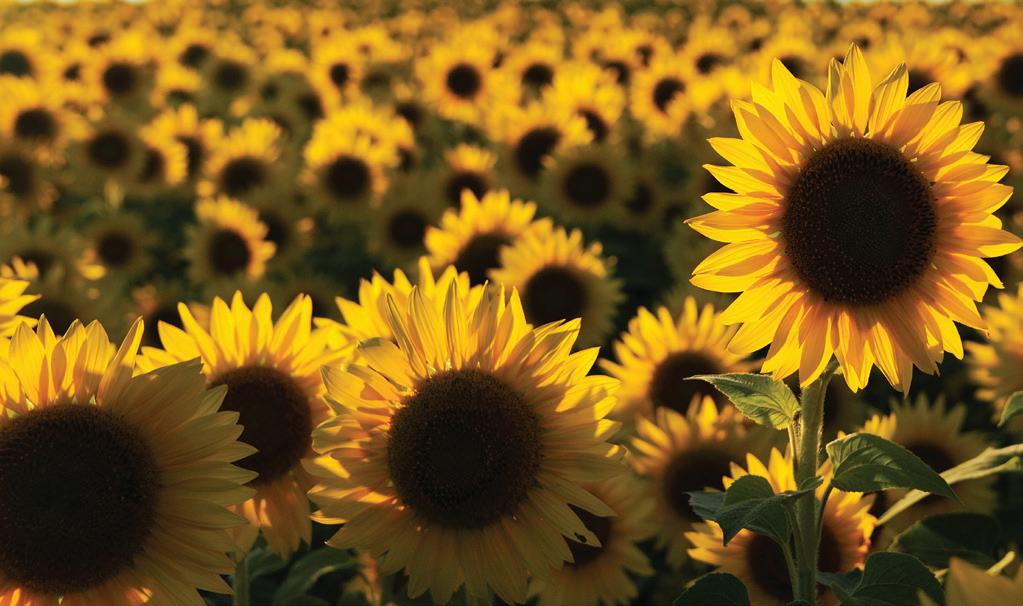
ed as saying. “The commercial adoption of GE crops began in 1996 with the introduction of herbicide-tolerant soyabeans and has seen unprecedented growth in area planted since.”
Bioceres manager of global seed and trait Martin Mariani said HB4 wheat could stabilise production in traditional
regions experiencing longer and more regular incidents of drought, and was the only available drought-tolerant wheat technology. HB4 wheat had also been approved for food and feed in Australia, New Zealand, Indonesia, Nigeria, South Africa, Colombia, Thailand and Chile.
German chemical and biotech giant BASF is preparing its agricultural chemicals business for an initial public offering (IPO) in the next few years as part of expected restructuring measures, according to a Reuters report based on a 18 September Bloomberg News article.
BASF’s agricultural unit comprises seeds & traits, crop protection, digital farming,
public health, urban & rural pest control, turf & ornamentals and animal nutrition divisions. The division focuses on selected crops: wheat, canola (oilseed rape) and sunflower in North America and Europe; soyabeans, corn (maize) and cotton in the Americas; rice in Asia; and fruit and vegetables globally.
The seeds & traits division uses germ-
plasms and trait-technologies designed to improve yields in countries including Brazil, Canada, Europe and the USA.
Since taking over as CEO in April, Markus Kamieth had continued his predecessor’s push to reduce BASF’s reliance on subdued European markets, while building a U$11bn chemical complex in southern China to tap into faster Asian growth, the report said.
30 October 2024
Fat & Oil Industry
InterContinental Hotel, Kyiv, Ukraine www.apk-inform.com/en/conferences/ fat-and-oil-indastry-2024/about
31 October 2024
3th Grain Academy Varna, Bulgaria https://grain-academy.com/
4-6 November 2024
Sustainable Aviation Futures APAC Congress
PARKROYAL Marina Bay, Singapore www.safcongressapac.com
6-8 November 2024
20th Indonesian Palm Oil Conference and 2025 Price Outlook (IPOC 2024) Bali Convention Center (BICC), Indonesia www.gapkiconference.org/ conference-details/agenda
7 November 2024
FOSFA Annual Dinner
The Brewery, London, UK https://fosfaannualdinner.co.uk/
7-9 November 2024
5th YABITED Fats and Oils Congress Antalya, Turkey www.yabited2024.com/EN/Default.aspx
11-13 November 2024
Roundtable Conference on Sustainable Palm Oil (RT2024)
Amari Bangkok, Thailand https://rspo.org/rt2024-save-the-date
12-14 November 2024
Global Grain Geneva 2024 Geneva, Switzerland www.fastmarkets.com/events/globalgrain-geneva
14-15 November 2024
Biofuels Expo 2024
Renaissance London Heathrow Hotel UK https://biofuelsconference.org
20-21 November 2024
10th ICIS Asian Surfactants Conference
Park Royal Collection Hotel, Kuala Lumpur, Malaysia https://events.icis.com/website/14105/
www.ofimagazine.com
9-11 December 2024
Hands-on Annual Vegetable Oil Deep Frying Course with Live Demonstrations College Station, Texas, USA https://fatsandoilsrnd.com/ annual-courses
20-21 January 2025
Fuels of the Future 2025 Berlin, Germany www.fuels-of-the-future.com/en
20-23 January 2025
Clean Fuels Conference 2025 San Diego California, USA www.cleanfuelsconference.org
30 January 2025
International Rendering Symposium, part of the International Production & Processing Expo
Atlanta, Georgia, USA www.ippexpo.org/education-programs
24-26 February 2025
Palm & Lauric Oils Price Outlook Conference & Exhibition (POC 2025) Kuala Lumpur, Malaysia
6-8 March 2025
Fats & Oils International Conference –Exhibition
JW Marriott Sahar, Mumbai, India https://foic.org.in/
10-11 March 2025
2nd The Future of Oilseeds: Prospects for Plant based Proteins? Frankfurt, Germany www.dgfett.de/meetings/aktuell/
16-19 March 2025
NIOP Annual Convention
Omni Rancho, Las Palmas Resort & Spa California, USA
https://niop.org/annual-convention-2024/
18-20 March 2025
International Biomass Conference & Expo Cobb Galleria Centre, Atlanta, Georgia, USA https://ibce.bbiconferences.com/ema/ DisplayPage.aspx?pageId=Home
7-8 April 2025
8th Leipzig Symposium Leipzig, Germany www.dgfett.de/meetings/aktuell/
27-30 April 2025
AOCS Annual Meeting & Expo Portland, Oregon, USA https://annualmeeting.aocs.org/
4-7 June 2025
EFPRA Congress 2025
Radisson Blu Latvija Conference & Spa Hotel, Riga, Latvia https://efpra.eu/events
9-11 June 2025
Sustainable Fuels Summit: SAF & Renewable Diesel & Biodiesel Chi Health Center, Omaha, Nebraska, USA https://few.bbiconferences.com/ema/ DisplayPage.aspx?pageId=Sustainable_ Fuels_Summit__SAF__Renewable_ Diesel__Biodiesel
10-11 June 2025
IGC International Grains Conference London, UK www.igc.int/en/conference/reginfo.aspx
11-12 June 2025
Oleofuels 2025
Barcelona, Spain www.wplgroup.com/aci/event/oleofuels
29 June-2 July 2025
16th Congress of the International Society for the Study of Fatty Acids and Lipids (ISSFAL) Quebec City, Canada www.issfalcongress.com
12-15 October 2025
Euro Fed Lipid Congress and Expo Leipzig, Germany
https://veranstaltungen.gdch.de/ microsite/index.cfm?l=11649&modus=
21-26 October 2025
North American Renderers Association Annual Convention Ritz Carlton Amelia Island, Florida, USA https://convention.nara.org
18-20 November 2025
MPOB International Palm Oil Congress and Exhibition (PIPOC 2025) Kuala Lumpur, Malaysia https://pipoc.mpob.gov.my/
For a full events list, visit: www.ofimagazine.com Information subject to change

Edible oils have been transported worldwide since the late 1970s from the same countries to the same destinations.
What has changed for the freight market has been the volumes transported, from small quantities loaded on general cargo ships to specialised chemical tankers now carrying up to 70,000-80,000 tonnes of palm or soyabean oils.
The main vegetable oil trade routes are from Asia to Europe, South America to Europe, and South America to China/India (see Figure 1, below).
Several dramatic changes have affected
Although the shipping of edible oils has remained relatively stable for decades, the onset of UCO exports, an ageing fleet, contraction of tonnage and regulations to cut emissions will all have an impact on the market going forward Francesco Morici
vegetable oil freight in the past three to four years.
Many companies, traders and producers have started to invest in the shipping of used cooking oil (UCO) and UCO methyl ester (UCOME) due to demand for these
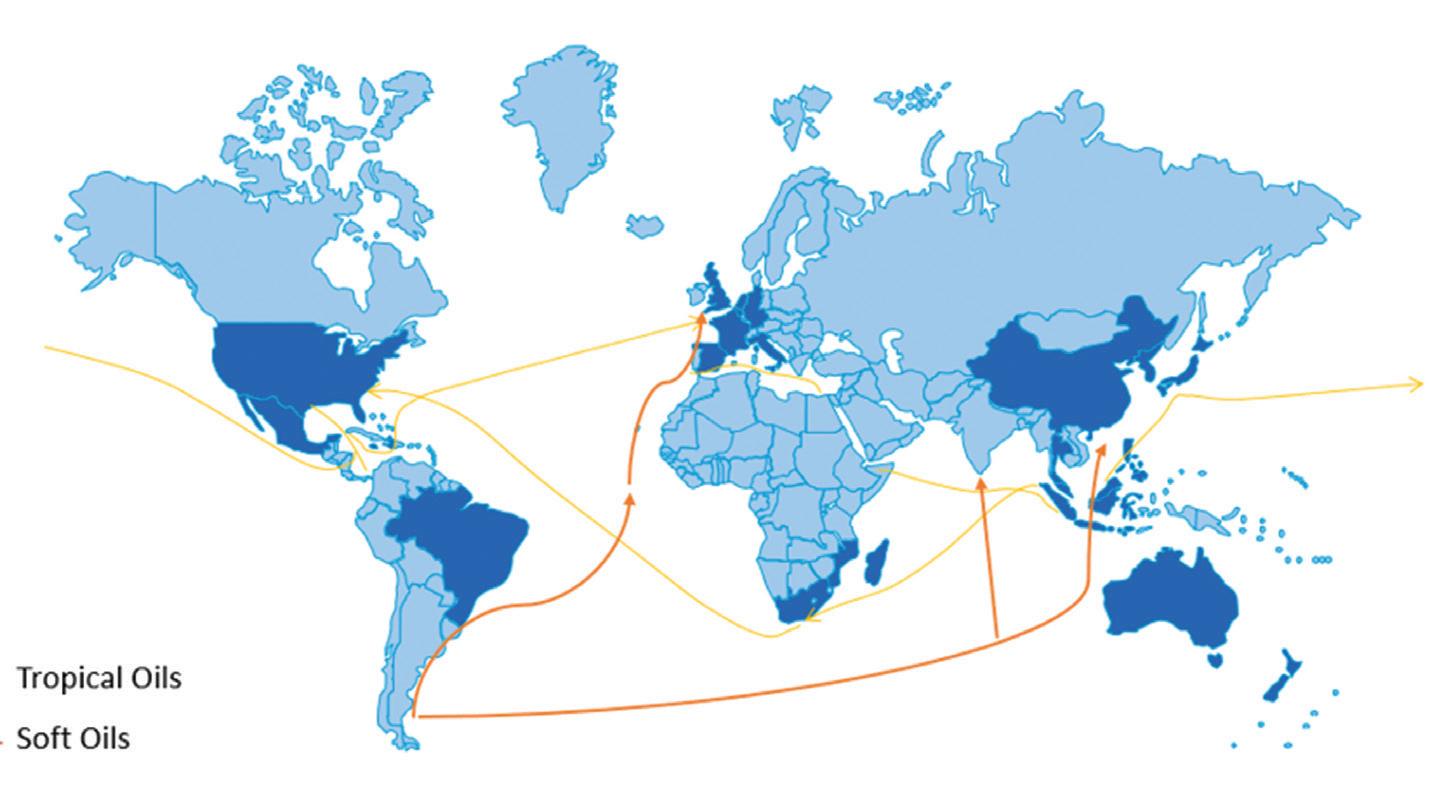

Source: Navquim
products as feedstocks for renewable diesel and sustainable aviation fuel (SAF). There has been a swing in tonnage, with vessels ships operating in the Clean Petroleum Products (CPP) and vegetable oil markets relocating their vessels to China, which has been a major shipper of UCO and UCOME to Europe.
This flow is now diminishing slightly due to new EU import taxes on Chinese biofuels announced in July. This may create a surplus of tonnage of vessels previously shipping these cargoes from China.
Vegetable oil freight rates have remained relatively stable since 2016/2017 even during the COVID-19 pandemic when other shipping markets – such as for containers – suffered big swings.
The first major shift in vegetable oil freight rates came when drought affected water levels at the Panama Canal at the end of 2023 (see Figure 2, following page).
From some 20 ships per day travelling northbound and southbound via the canal,
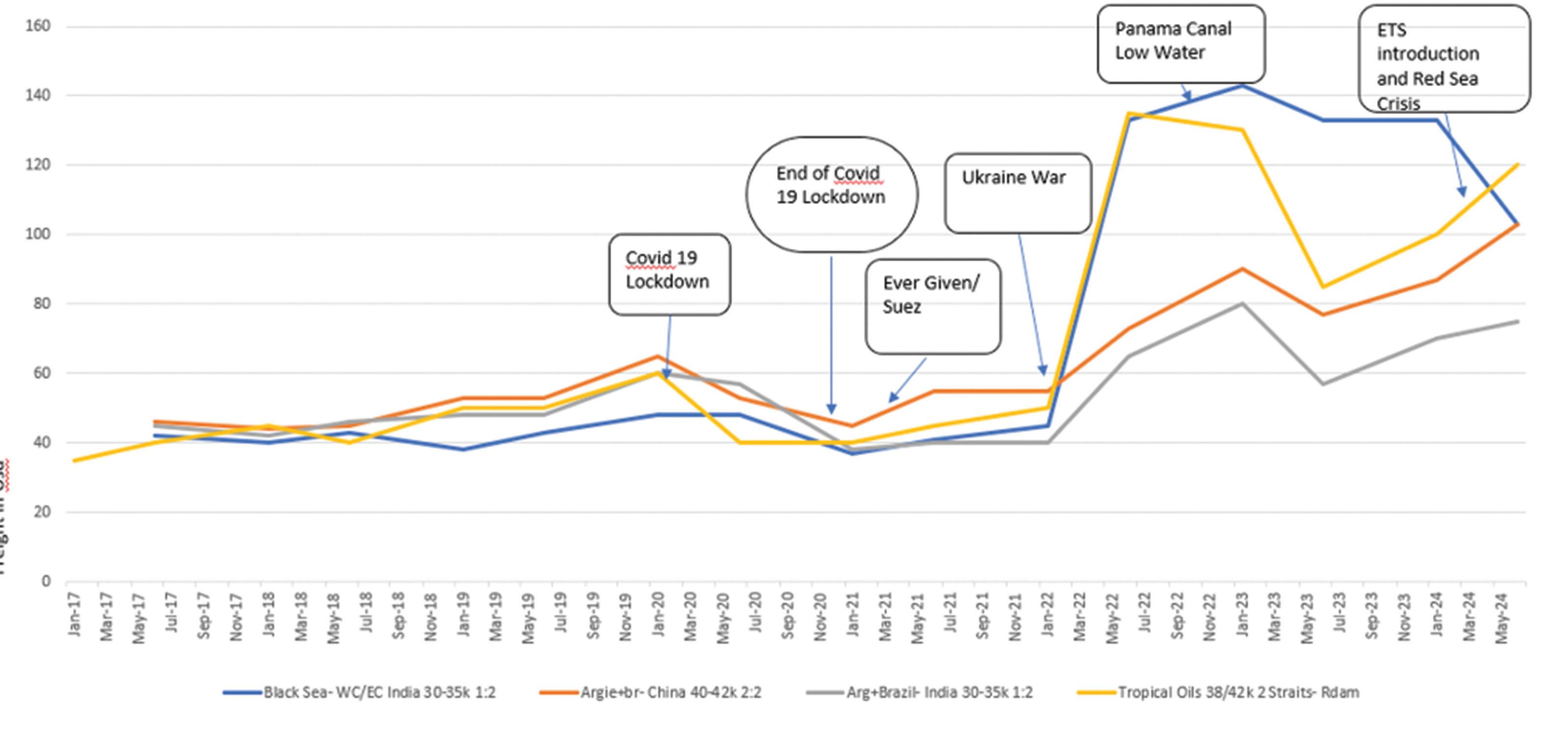
numbers fell to some four to five ships per day. This caused major delays on both sides of the canal, with bidding rates to secure passage on arrival rising from the normal US$10,000–$15,000 premium to US$350,000–$400,000 for container, cruise and LNG ships.
For producers shipping some 30,000–40,000 tonnes of palm or soyabean oils, the premium could have represented almost the entire cost of their freight.
Vegetable oil cargoes from Asia to the USA therefore re-routed via the Cape of Good Hope to avoid the Panama Canal, increasing their voyage time by about 15 days.
The other big spike in the vegetable oil freight market resulted from Houthi attacks on vessels in the Red Sea, affecting ships passing through the Suez Canal – the quickest sea route between Asia and Europe. Most ships bound from Asia to Europe re-routed around the Cape of Good Hope, increasing their transit time by about 12-15 days, as well as incurring additional costs such as for bunker fuel and emission credits.
The classic sunflower oil route from the Black Sea to India was around US$40/ metric tonne, but tripled to some US$$120/metric tonne following Russia’s invasion of Ukraine in February 2022. The price of insurance became very high and many ship owners avoided Ukraine due to high costs and risk.
Some traders and producers in Ukraine invested heavily in second hand tonnage
because the cost of freight and insurance was becoming so high that it was cheaper for them to buy a second hand vessel to ship their product locally or a short distance than to charter a ship. Two years on, there is a fair amount of this tonnage owned by non-ship owners impacting the Intra-Mediterranean freight market. Freight rates as of June 2024 for this route were around US$100/metric tonne.
The Argentina/Brazil route to China/ India has been more consistent, with geopolitical factors showing less of an influence and no need to pass through the Panama or Suez canals. Rates to move Argentine and Brazilian soyabean oil to China and India have increased due to tonnage moving to Asia to ship UCO and UCOME from China to Europe, and are currently around US$60-80/metric tonne.
The Palm Oil Straits to ARA (Antwerp/ Rotterdam/Amsterdam) route has hovered around the US$40-60/metric tonne level since 2017 but rose four-fold following the drought problems at the Panama Canal and the Red Sea crisis. Most reputable large chemical and palm oil companies now avoid using the Red Sea.
The workhorse vessel used by most vegetable oil majors in the trade is the Japanese-built, 19,000 dwt, stainless steel J19 vessel, dating back to the early 2000s. The ship is flexible and used by the palm oil and chemical trades because of its flexibility and stainless steel tanks, allowing carriage of different kinds of products. The hire rate for this benchmark ship
was around US$14,000-15,000/day until the COVID-19 pandemic. Soon after from the summer of 2022, rates peaked at around U$50,000/day, due to the Panama and Red Sea crises, for J19s trading between Asia to Europe shipping UCO and UCOME to Europe. Rates have since fallen from those peaks.
The CPP market also has a direct influence on the chemical/vegetable oil market. CPP vessels of 50,000-60,000 tonnage like to enter the chemical/ vegetable oil market when these markets are stagnant as they can offer a cheaper cost per tonne of cargo rate. When the CPP market picks up, these ships quickly disappear and the market returns to the traditional chemical owner.
The shipping industry reacts to any major events relatively slowly, with changes only appearing months after the event itself.
One of the biggest challenges currently facing the vegetable oil trade, and the chemical market in general, is an ageing fleet and contraction of tonnage, with very few new ships coming into market.
Most of the world’s major shipyards – in Japan and China – are very busy renewing tonnage for container companies which, after many years of losses, have been enjoying astonishing results in the last two to three years. Danish shipping firm Mærsk A/S, for example, reported a profit of US$15bn in just one quarter.
Container companies are now investing heavily in new and bigger ships and may typically order 10-15 ships, compared to just two to five new chemical ship orders. u
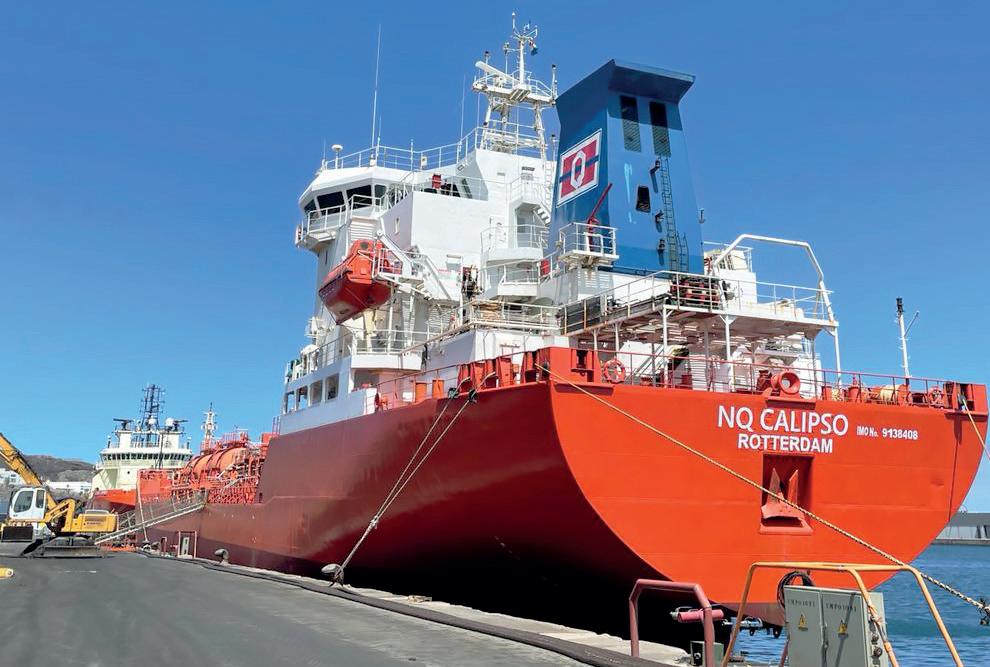
Most Chinese and Japanese shipyards are more interested in constructing container ships – which are easier to build and require less labour – than highly specialised stainless steel ships which need specialised shipyards, a larger workforce, as well as more stainless steel material.
Ship owners coming out of many years of losses since the 2007/2008 global financial crisis are therefore refraining from ordering new specialised vessels because the price of these ships is currently too high and because it is difficult to find the specialised shipyards to build them.
The current average age of vessels shipping vegetable oils is around 16 years old, with no new ships forecast to come on line until 2026/2027, and only amounting to a fraction of what the market needs.
The European Commission’s announcement on 19 July that it would impose provisional anti-dumping tariffs of up to 36.4% on biodiesel imports from China will have an impact on shipping from the country.
Clean fuel advocacy group Transport & Environment has said that the tariffs are a step in the right direction in limiting imports of potentially fraudulent UCO from China, which has flooded the European market in the past two years.
The EU import duties may lead to the USA taking in more UCO and UCOME for its renewable diesel/SAF sector.
The definition of what is UCO and UCOME is also having an impact on the shipping and labelling of these products.
All cargoes are classified by the International Convention for the Prevention of Pollution from Ships (MARPOL) according to their environmental risk.
MARPOL sets out guidelines for products such as UCO, UCOME, palm oil methyl ester (POME) and fatty acid methyl ester (FAME), such as how to dispose of their residual slop following tank cleaning.
Adopted in July 2023 and coming into force on 1 January 2025, the FuelEU Maritime Regulation promotes the use of renewable, low-carbon fuels and clean energy technologies for ships to support decarbonisation in the sector.
FuelEU Maritime sets maximum limits for the yearly average greenhouse gas (GHG) intensity of the energy used by ships above 5,000 gross tonnage calling at European ports. Shipping companies need to reduce their GHG emissions by 2% next year, and gradually by 80% by 2050 by implementing the use of biofuels blending for their ships.
Currently, there are no fuels available on a large scale to help shipping companies comply with this mandate.
One tonne of marine fuel may require 3-5 tonnes of alternative fuel, meaning about 1.4-1.5M tonnes are needed in Europe to reduce GHG emissions by 2%.
There is currently not enough alternative fuels for marine consumption, and not enough available in every part of the world. In addition, the marine sector will need to compete with the similar EU ReFuelEU SAF mandate for the aviation sector coming into force in 2025.
The engines of the current 16-year-old worldwide fleet shipping vegetable oils are also not technologically equipped to change from traditional fuel to alternative fuel, such a methanol and ammonia, without substantial modification that, due to the ships’ age, may not be justified and promptly recovered.
New builds the sector may see in 2026/27 may have dual capacity to use e-methanol or ammonia but the market still requires these fuels to be available on a large scale. These fuels are also new technologies very much in their infancy.
The EU Emissions Trading System (ETS) launched in 2005 requires polluters to pay for their greenhouse gas (GHG) emissions to help bring overall EU emissions down. Since January 2024, the EU ETS has been extended to cover carbon dioxide (CO2) emissions from all large ships (5,000 gross tonnage and above) entering EU ports. The system covers:
• 50% of emissions from voyages starting or ending outside of the EU (allowing the third country to decide on appropriate action for the remaining share of emissions);
• 100% of emissions that occur between two EU ports and when ships are within EU ports.
The ETS covers CO2, methane and nitrous oxide emissions, but the latter two only from 2026.
In practice, shipping companies have to purchase and use EU ETS emission allowances for each tonne of reported CO2 emissions in the scope of the EU ETS system. Shipping companies only have to surrender allowances for a portion of their emissions during an initial phase-in period:
• 2025: for 40% of their emissions reported in 2024
• 2026: for 70% of their emissions reported in 2025
• 2027 onwards: for 100% of their reported emissions
The first surrendering deadline is due in September 2025 in all EU member states, with respect to emissions reported as taking place from 1 January 2024 to 31 December 2024.
This will add an extra layer of cost that is not easily recoverable by charterers. ● This article is based on a presentation made by Francesco Morici, chartering manager at Navquim, Spain, at OFI International 2024 on 9-11 September. Morici is also a member of the FOSFA Oils and Fats Technical Committee and an accredited FOSFA arbitrator

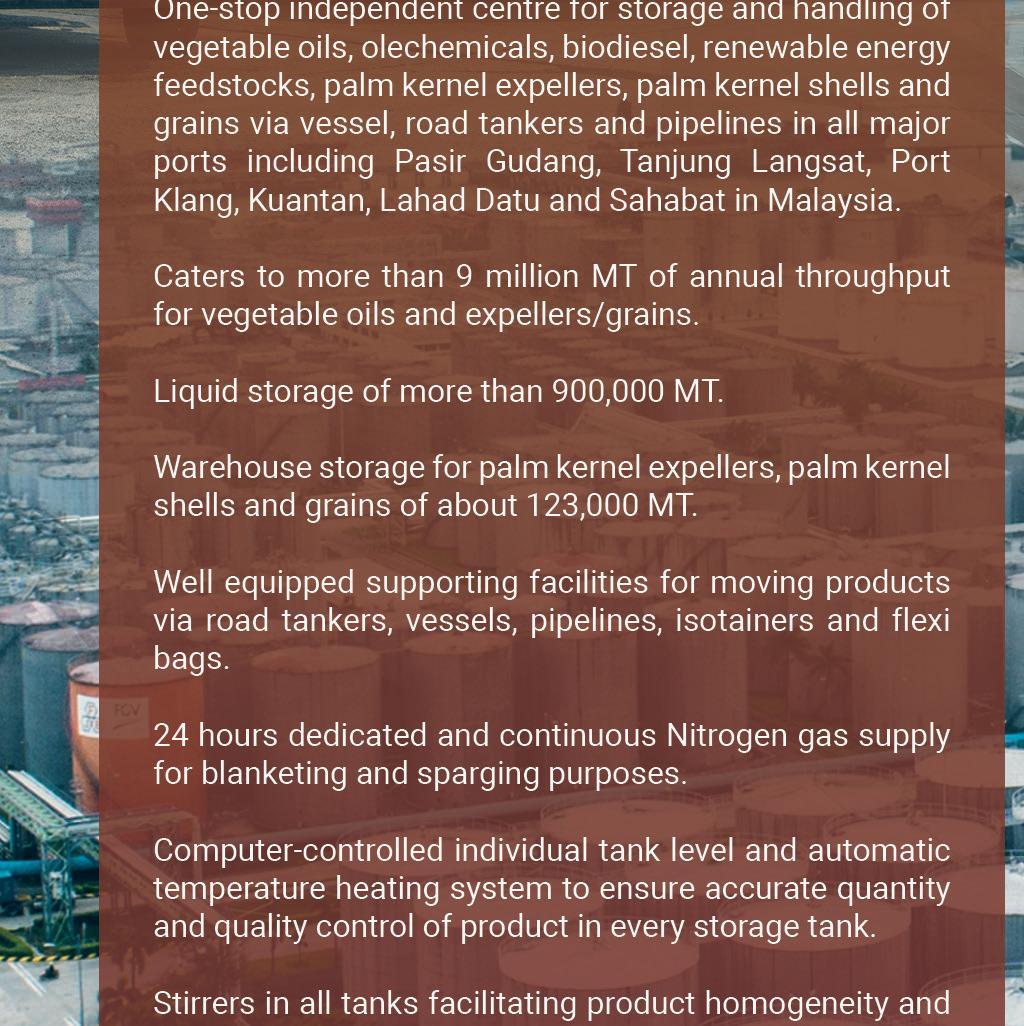







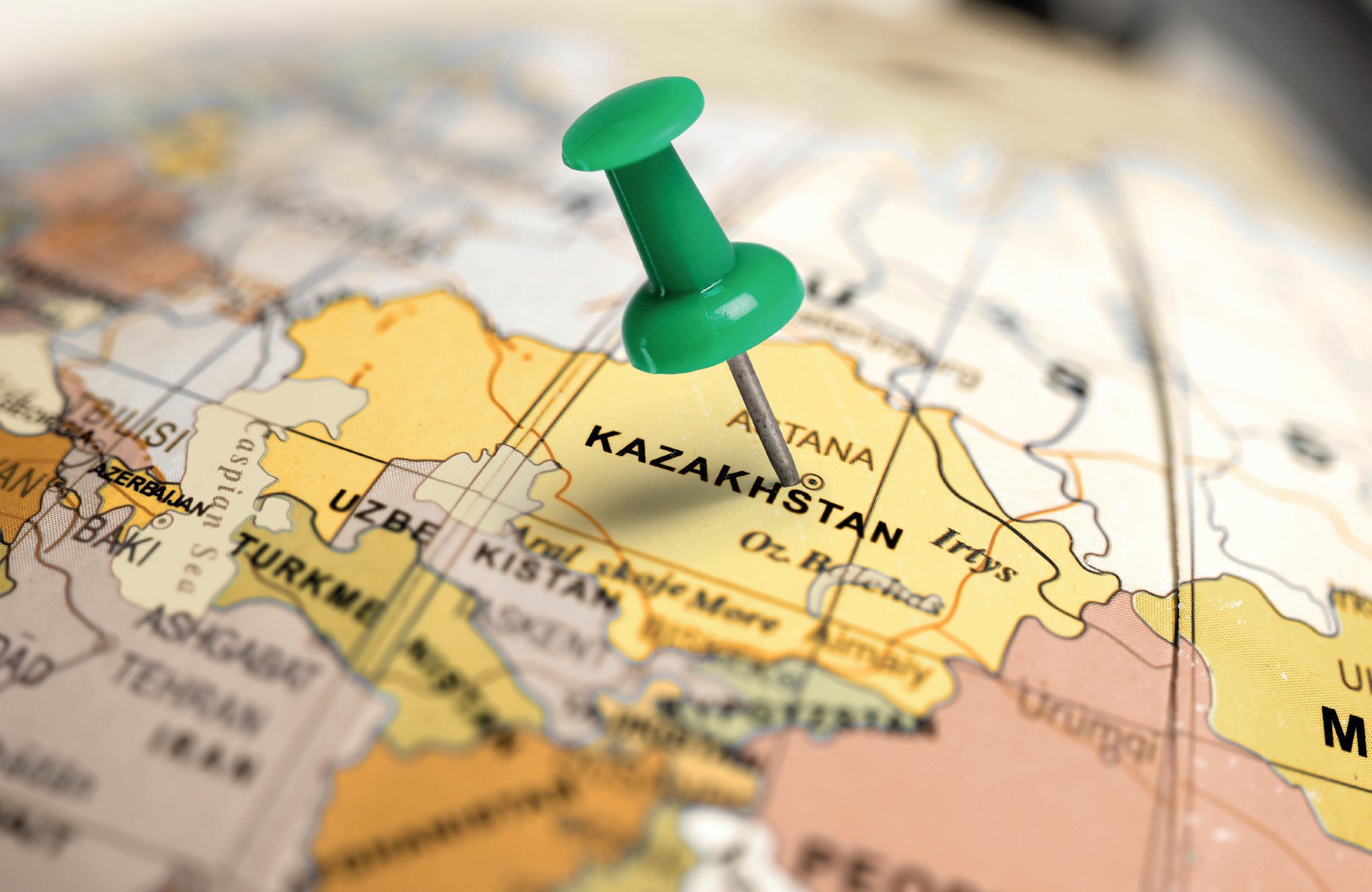
Until three years ago, Kazakhstan was the world’s leading global flaxseed producer, according to a report by the US Department of Agriculture (USDA).
By the time of the 20 August Kazakhstan: Grain and Feed Update report, however, Kazakhstan had dropped into second place behind Russia.
Together with Canada, the three countries account for 88% of global production, according to the USDA Foreign Agricultural Service (FAS) report.
Other major flaxseed producers include China, India and the USA.
A number of outside factors could benefit Kazakhstan’s flaxseed sector, such as the European Union (EU)’s import duty on all Russian wheat and oilseeds, the USDA report said.
Introduced on 1 July, the EU’s 10% import duty on Russian wheat and oilseed is set to increase to 20% on 1 January 2025 and to 50% on 1 January 2026.
“This year, farmers expect wheat prices will go down and flaxseed prices will go up as the European Union introduced an import duty on all Russian wheat and oilseeds,” the FAS said.
“Kazakhstan producers plan to replace Russia and supply flaxseed to [the] European Union.”
One of the leading global flaxseed producers, Kazakhstan is expecting a bumper crop this year following last year’s below average harvest Gill Langham
In its Kazakhstan report, the USDA said: “Kazakhstan is expected to have a bumper crop following last year’s troubled production.
“After heavy rains and flooding in May delayed planting, Kazakhstan’s primary growing regions have had near perfect weather, greatly raising the outlook for the upcoming harvest.”
Talgat Aldazharov, managing partner and CEO of Kazakhstan-based vertically integrated holding company Aitas Agro and head of the production committee at the Kazakh Grain Union, agrees.
The Kazakh Grain Union has 171 grain market members, comprising producing companies and farmers, trading companies, storage elevators, chemical and machinery suppliers, and survey and certification companies.
Its members farm more than 3M ha of land (17% of the country’s total planted area), offer more than 6.5M tonnes of grain storage capacity and export more than 5M tonnes/year of grains.
production estimates for this year are around 1M tonnes – compared to 361,000 tonnes in 2023 – following a 2030% increase in planted area (see Figure 1, following page)
“We are also expecting a much higher yield. Last year we had a very poor year but this season, the expectation is we will have the highest flaxseed yield historically,” Aldazharov says.
“Improved weather conditions are also helping to improve yields but we still have a very high risk of rainfall during harvesting.”
Agriculture is a key part of Kazakhstan’s economic, social and environmental development. The country is Central Asia’s largest grain producer and the region’s only significant exporter, according to World Bank data reported by World Grain
The ninth largest country in the world, Kazakhstan has significant agriculture potential and has the world’s fifth largest area of agricultural land, comprising
According to Aldazharov, flaxseed u
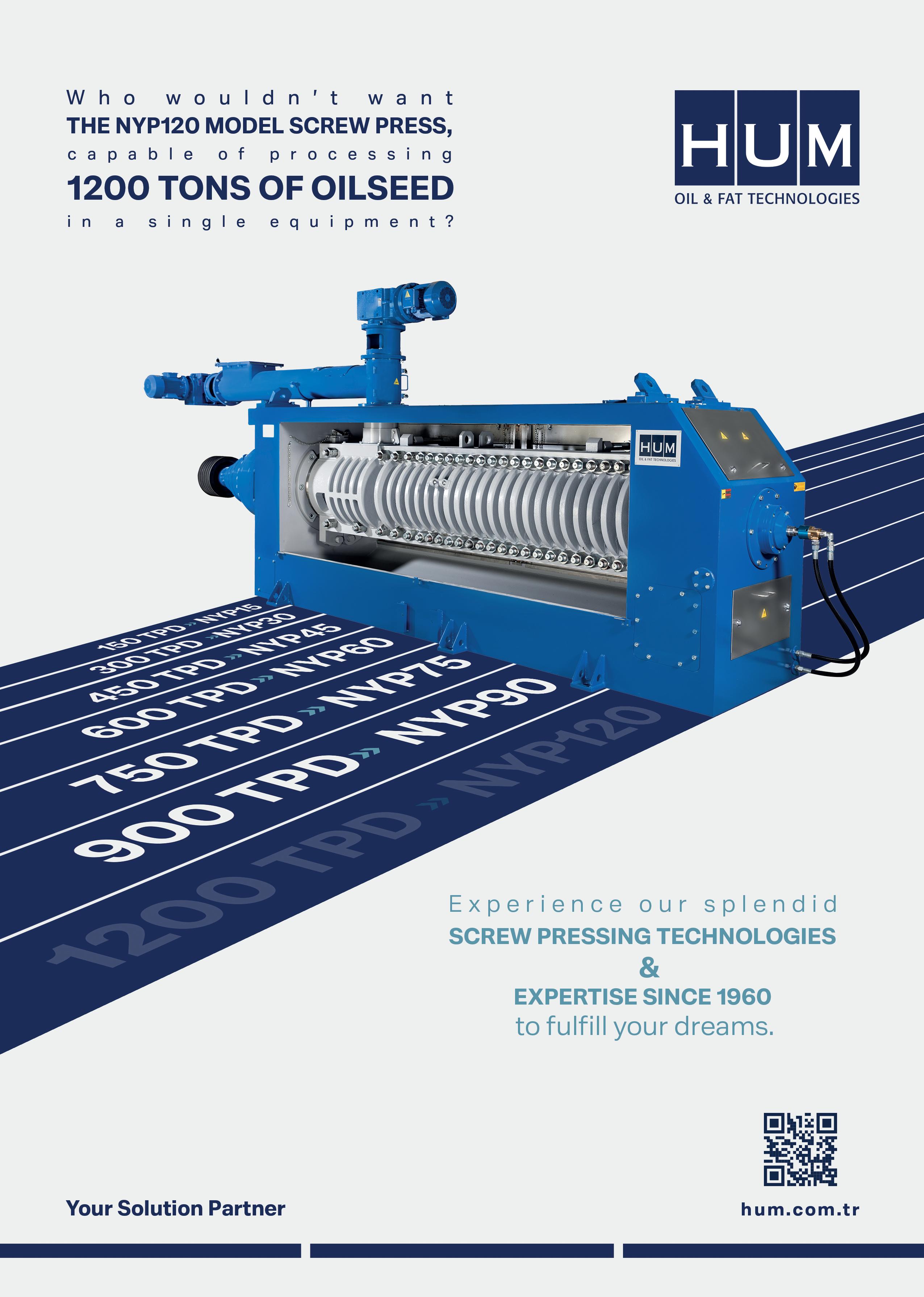
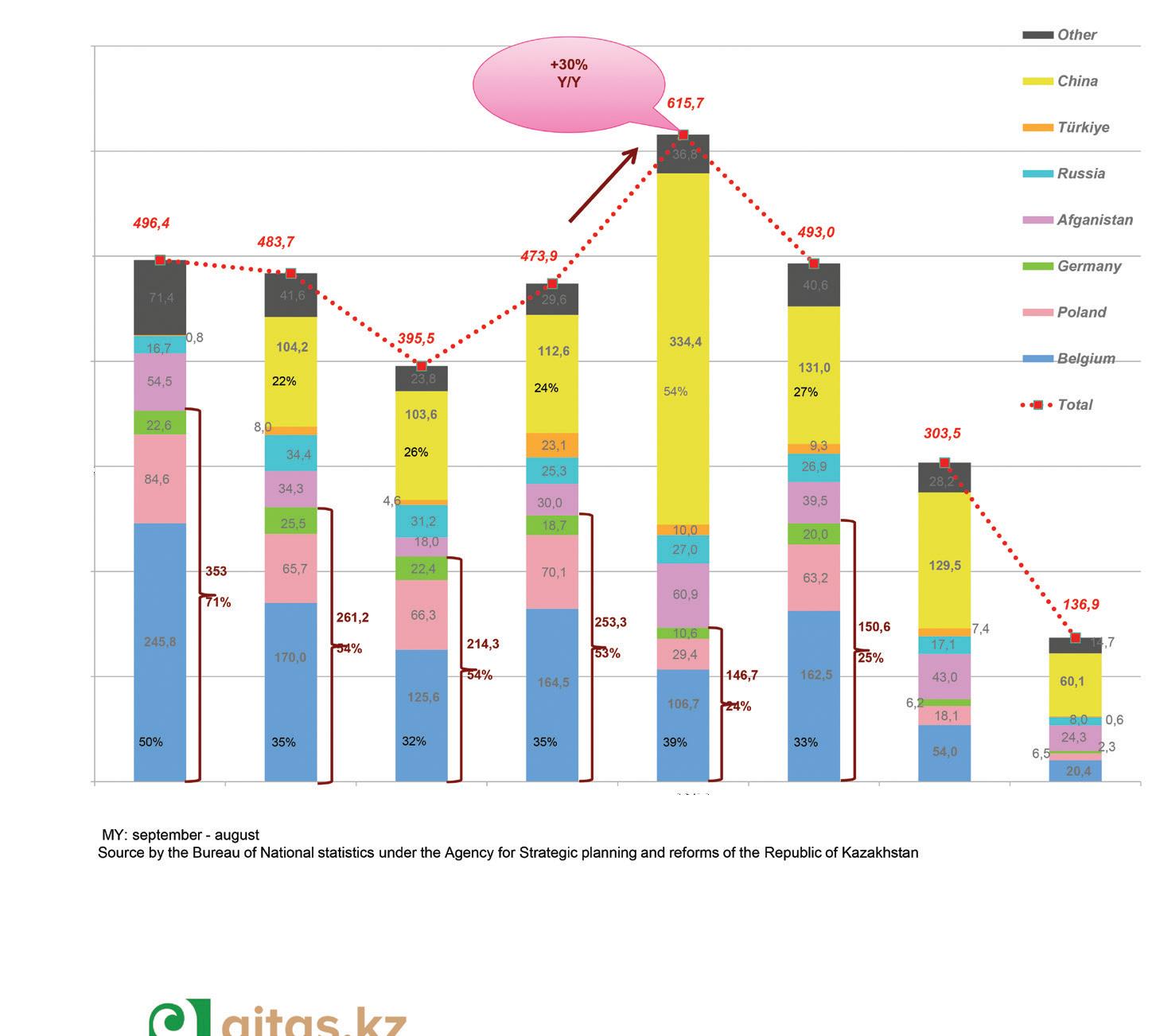
25M ha of arable land and more than 70M ha of pastureland, according to the 24 June World Grain report.
In its May report, Republic of Kazakhstan: Climate Adaptation Options and Opportunities in the Agriculture Sector, the World Bank says there has been a gradual increase in the cultivation of oilseed crops (flaxseed, sunflower and safflower) in Kazakhstan between 2012-2021 from 1.29M ha to 2.67M ha. The planted area for pulses (dry peas, soyabeans, lentils and chickpea) also increased from 200,000ha to 290,000ha in this period.
Crop diversity has gradually increased in Kazakhstan over the last five to 10 years, the World Bank says.
The area for oilseed crops, especially flaxseed, sunflower and safflower in the Northern, Eastern and Western zones, has increased while pulses (dry peas, soyabeans, lentils and chickpeas) have been gradually increasing across all
zones except the South.
According to the USDA report on the country, the Bureau of National Statistics recorded the country’s total planted area at 23.31M ha on 2 August. This comprised a wheat area of 13.15M ha and a barley area of 2.28M ha. Oilseed crops were planted on 2.9M ha.
Kazakhstan produces up to 25M tonnes of main grain and oil crops with more than half of it going to export, Aldazharov says.
Neighbouring Russia, China, Central Asia countries, Iran and the Caucasus, the country benefits from an advantageous geographical location, favourable conditions for agriculture, a stable political environment and government support for investment projects, he adds.
According to the country’s Bureau of National Statistics, the country had a population of around 20M in 2024 as of 1 August 2024.
Kazakhstan also enjoys proximity to
large markets and growing investment in transport and trade corridors, the World Bank says.
The government is looking to take advantage of the agriculture sector’s untapped potential for exports, jobs and inclusive and sustainable growth, according to the World Bank.
However, critical investments and transformations are needed in the public and private sectors.
Kazakhstan developed a national agricultural sector development project plan for 2021-25 to increase competitiveness by improving labour efficiency, doubling agricultural exports, domestically producing key food products and increasing rural incomes, the World Bank says.
Plans to increase labour efficiency include subsidies to agricultural producers to purchase equipment, increasing land area under irrigation, increasing the average cattle weight, increasing the use of high-quality seeds, fertilisers and pesticides, and introducing agricultural research and development to producers.
Since the 2000s, Kazakhstan has seen impressive economic growth driven by the first generation of market-orientated reforms, abundant mineral resources extraction and strong foreign direct investments, according to the World Grain June report.
Sustained economic growth has transformed the country into an upper middle-income economy, raising living standards and reducing poverty, the report says.
Over the last 10 years, however, Kazakhstan’s growth has slowed from 10% from 2000-2007 to below 4%, highlighting the vulnerabilities of the economy.
After rebounding from the adverse impacts of Russia’s invasion of Ukraine in 2022, the World Bank expects the country’s growth to slow to 3.4% year-onyear in 2024 due to lower-than-expected oil production, with a rise to 4.7% in 2025.
Kazakhstan’s economic outlook for the next two years is steady growth, driven in part from its continued reliance on hydrocarbons and by stronger consumer spending, according to World Bank report Kazakhstan Economic Update, Winter 202324 - Shaping Tomorrow: Reforms for Lasting Prosperity
Looking ahead, adjusting to the global green transition presents significant challenges for the country, according to the World Grain report.






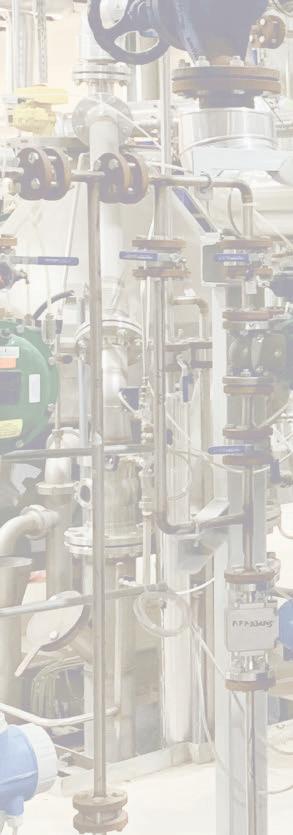









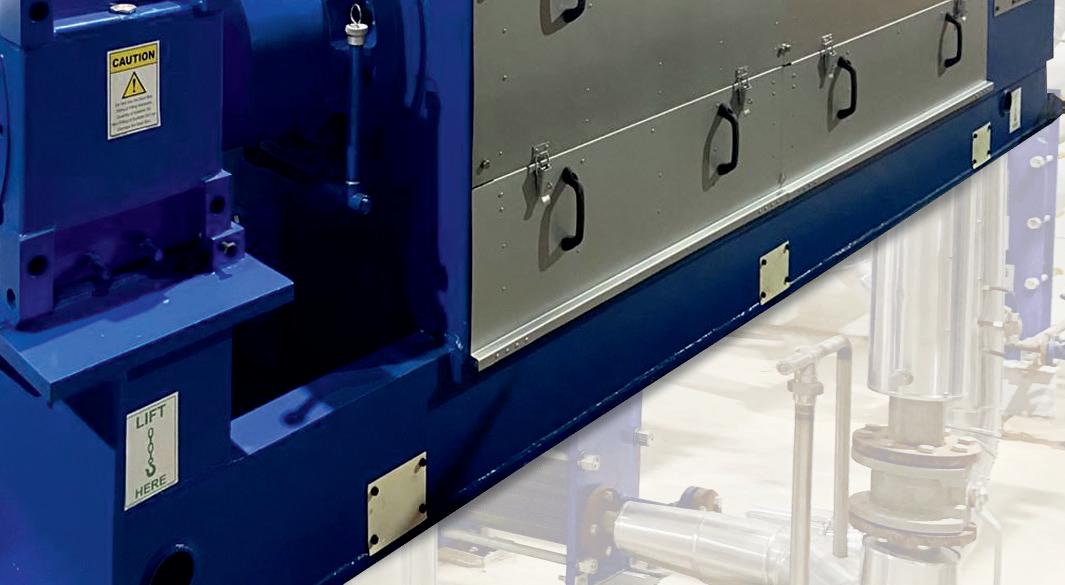


Kazakhstan’s flaxseed is mainly sold for its oil content
Wheat is Kazakhstan’s largest crop by acreage, covering a planted area of around 11M ha and accounting for 80% of grain production.
Production in 2024/25 is estimated at 15.8M tonnes, according to an USDA Foreign Agricultural Service (FAS) report on 17 June.
In addition to flaxseed and wheat, Kazakhstan produces barley, cotton, durum, sunflowerseed and rice.
Barley covers a planted area of just over 2M ha, durum around 0.5 ha, corn just under 0.2M ha, with all other cereals covering around 0.5M ha, Aldazharov says.
Oilseed crops cover around 3M ha of land and the main oilseed crops are sunflowerseed (around 1.3M ha) and flaxseed (around 1M ha), he says. All other oil crops cover around 0.5M ha.
Lentil is the main legume crop, covering up to 0.3M ha and peas are planted on 0.2M ha of land.
A combination of factors has increased the popularity of flaxseed as a crop among local farmers, Aldazharov explains.
Factors include: lower prices for wheat – the country’s main crop – last year; the effects of a 20% or minimum €100 (US$111) export duty on sunflowerseeds; increased interest from China; and the low cost required to introduce flaxseed into existing crop rotation systems.
The three main flaxseed producing
provinces are North Kazakhstan, Akmola and Kostanay.
With low domestic flaxseed consumption, the country’s flaxseed exports are steady and increasing alongside expanding production, Aldazharov explains.
Kazakhstan’s flaxseed is mainly sold for its oil content, he says.
“There is almost no domestic consumption and even when the flaxseed is processed locally, the oil usually goes to export, with the meal going to the livestock industry.”
Flaxseed oil, also known as linseed oil, is used in the production of paint, printing inks, linoleum and varnish and is also used in the pharmaceutical and general chemical sectors.
Food-grade linseed oil can be taken as a nutritional supplement and can also be used in cooking.
Kazakhstan’s government sees China as an important trading partner and is working to build relations with its eastern neighbour, according to the World Grain June report.
The countries have proposed the creation of a joint sub-committee on co-operation in agriculture, with a working group made up of transport and agriculture employees from Kazakhstan and railway and customs employees from China, the report says.
Against this backdrop, Kazakhstan’s flaxseed exports to China have increased,
particularly last season, Aldazharov says (see Figure 2, previous page)
“Five years ago, there were almost no exports to China but the country has now become more and more important as an importer.
“This is due to its geographical proximity, lower logistics costs and reduced pressure on quality.”
Other important export destinations include Belgium, other EU countries like Poland, while there has been some interest from Turkey and Afghanistan, Aldazharov says.
Although a large flaxseed crop is anticipated in Kazakhstan this year, a lack of demand from traditional markets like Iran and transit issues and barriers in China and Russia all present active challenges to exports, according to the USDA report.
For example, only the Vistotsky Port on the Baltic Sea in Russia was available for Kazakhstan exporters of flaxseed shipments to Belgium, an important importer, the USDA said.
According to Aldazharov, the country’s flaxseed sector faces a number of challenges, including increasing pressure on key markets from Russian commodities, more competition for the Chinese market and logistical challenges.
“The main challenge is logistics to the main markets. Europe is so distant and the main road is through Russia. China is an important importer but, at times, there is an issue with rail access.”
There is also a risk of sanctions on all commodities that transit Russia – still the main route for Kazakhstan to export commodities to Europe, Aldazharov says.
Due to weather conditions, an increase in weeds and pests is also expected this season, he adds.
On a positive note, Aldazharov says local farmers and traders are showing increasing flexibility and Russian supplies could be curtailed due to drought conditions in southern regions and frost in central Russia earlier this year.
A combination of improving export infrastructure to China and EU sanctions on Russian commodities could also open up opportunities for flaxseed exports, he adds.
“I expect the sector will continue to develop or at least to maintain this year’s level due to increasing demand from China and the decreasing profitability of other main crops.”
● Gill Langham is the assistant editor of OFI



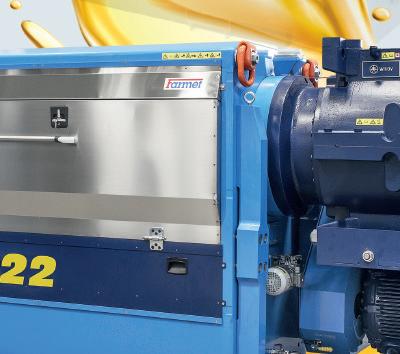


The effective technology and complex services
STATE-OF-THE ART OILSEEDS AND OIL PROCESSING TECHNOLOGIES
■ Horizontal agriculture
■ Local mechanical processing
■ Patented system of energy recovery
■ Complex approach including Physical Oil Re ning
■ Unique combination of extruders and screw presses
the industry’s number 1 choice over 39 years covering oil crops & animal fats
The January 2025 edition of OFI will include the following articles:
Plant, Equipment and Technology round-up
Shipping/transport/storage/logistics
Rendering
Asia focus
Lauric oils
Advertising please contact Mark Winthrop-Wallace markww@quartzltd.com

Maximize the life of your frying oil.
Our experts will work with you to optimize your frying operations and oil quality. The addition of DALSORB® oil purifier will extend the life of your frying oil and improve overall product quality.
DALSORB® keeps your food wholesome and removes undesirable compounds to keep frying oil clean from:
Off-odors
Off-flavors
Off-colors
Free fatty acids
Polar compound formation

During the past few years, the landscape for US renewable diesel/HVO production has drastically changed. Driven by federal and state policies aimed at reducing emissions, this dramatic US production and capacity growth is causing significant, market-altering shifts both domestically and to foreign feedstock trade.
Renewable diesel, like biodiesel, is produced from the same feedstocks such as vegetable oils, animal fats or used cooking oil (UCO). The difference is that renewable diesel is produced using a hydrogen treatment, making it chemically equivalent to petroleum diesel. It can therefore be blended at higher levels and transported using existing pipelines.
As a result, the USA is rapidly expanding imports of animal fats and vegetable oils to use as feedstocks for renewable diesel production, as well as to substitute soyabean oil that has been diverted to renewable diesel production.
US soyabean crush has expanded to produce more oil, producing an abundance of soyabean meal which has boosted US meal exports.
Domestically, US soyabean oil premiums rocketed so far above global vegetable oil prices that US exports plummeted, and the USA became a net soyabean oil importer for the first time in 2023.
US soyabean exports have also declined due to expanding Brazilian supplies and slowing growth of global import demand.
While many wild cards could affect the US biofuel, animal fats and oilseed markets, renewable diesel production is anticipated to continue to grow and alter
The boom in US renewable diesel production has impacted global trade of soyabean meal, as well as the country’s imports of oils and fats, with the USA becoming a net importer of soyabean oil in 2023 for the first time US Department of Agriculture
feedstock markets. The rate of production growth, however, will be highly dependent on federal and state policies, availability of feedstocks and sustained US soyabean meal export gains.
The dramatic expansion of US renewable diesel production in the past few years is policy-driven. Demand for renewable diesel is propelled by the carbon-emission reductions it provides relative to petroleum diesel and, unlike biodiesel, it can be used as a substitute for petroleum diesel rather than limited to blending at low levels.
Petroleum and renewable diesel are so similar and substitutable that they compete on an energy-adjusted price (petroleum diesel has a slightly higher energy content). However, the production cost of renewable diesel is significantly higher, leading to a sizeable premium over petroleum diesel. Thus, without federal and state carbon-reduction policies mandating minimum quantities and providing tax credits, there would not be a market for renewable diesel production.
From a federal standpoint, there are two main policies incentivising the production of biomass-based diesel, which includes both renewable diesel and biodiesel.
The first is the Blender’s Tax Credit,
which provides tax relief for blending biomass-based diesel into the US diesel pool. This partially offsets the higher production cost of biomass-based diesel and helps to narrow the premium over petroleum diesel. The second federal policy is the Renewable Fuel Standard (RFS), which mandates blending of biofuels – such as biomass-based diesel, sustainable aviation fuel (SAF) and ethanol – into the total US fuel pool.
While these federal laws are incentivising the growth of biofuels, the real driver for renewable diesel expansion has been the California Low-Carbon Fuel Standard (LCFS). Like the blender’s credit, this policy offsets higher biomassbased diesel production costs through a carbon credit for meeting emission targets and has driven renewable diesel consumption in California. Since California had already reached blending maximums for both ethanol (10% of gasoline pool) and biodiesel (5% of diesel pool), blenders needed to utilise other carbon-emissionreducing alternatives such as blending more renewable diesel, using more SAF, or lowering the carbon emissions of existing biofuel consumption.
As a result, renewable diesel has expanded as it does not have a blending ceiling and because of an influx of private
investment to increase production capacities, spurred by the long-term demand stability created by the LCFS.
While the RFS sets a national mandate for biofuel consumption, the LCFS created a strong financial incentive that pulled most of the renewable diesel volume to the Californian market. Between 2020 and 2023, growth in Californian consumption of renewable diesel was more than double the consumption growth throughout the rest of the USA.
As a result, biomass-based diesel accounts for about 60% of the California diesel pool while the rest of the USA remains in the low single digits. While Oregon and Washington have similar state policies to the LCFS, California is the largest-consuming and fastest-growing state and is responsible for driving the meteoric ramp-up of renewable diesel capacity and production.
Lastly, key market factors have helped aid the expansion of renewable diesel production during the past few years. First, the process and equipment needed to make renewable diesel (and SAF) is similar to that used to make petroleum diesel. This allowed companies to convert part, or all, of a few existing refineries from producing fuel from petroleum into making renewable diesel and SAF from animal fats, vegetable oils, and hydrogen. Many of the decisions and announcements to repurpose refineries for renewable diesel came in 2020 and 2021, when idle capacity at petroleum refineries hit decade-highs due to COVID-19 impacting oil consumption and prices. This also coincided with the industry’s gradual transition from crude oil petroleum companies to energy companies through investments in alternative energy sources. Additionally, renewable diesel was able to expand quickly at the expense of biodiesel, as the two compete for the same feedstocks. As production of renewable diesel has expanded, biodiesel has gradually trended the opposite direction since peaking in 2018. US renewable diesel production capacity surpassed biodiesel in July 2022, which led to renewable diesel production exceeding biodiesel in 2023.
The explosion in renewable diesel capacity and production (see Figure 1, following page) has significantly bolstered US demand and imports of vegetable oil and animal fat feedstocks. For example, canola oil imports surged during the past two years as a direct result of expanding renewable diesel production and policy changes (see Figure 2, following page). In
December 2022, the US Environmental Protection Agency announced that canola oil met RFS renewable diesel feedstock requirements. As a result, US canola oil imports jumped to a record level. While most of this demand was for biomassbased diesel production, some of the increased supplies were used for food, substituting the displaced soyabean oil that had been re-routed to produce renewable diesel. This is unlikely to be a short-term spike, as US canola oil imports, food use consumption and industrial consumption are all forecast to be records for the third consecutive year in 2024/25. With a free trade agreement and
geographical proximity to Canada, the world’s largest canola/rapeseed oil exporter, the USA will continue to have access to ample supplies. In the past few years, the USA has jumped from accounting for 50-60% of Canada canola oil exports to 91% in 2023. Canola oil supplies should also remain robust as Canada has announced plans to expand crush capacities in the next few years.
Canola oil provides a clear example of how US import demand can spike as a direct result of renewable diesel expansion, but this trend is not unique. In 2022, the main feedstocks for renewable diesel were yellow grease, tallow and u







Source: Capacity –FarmDoc analysis; Production – US Energy Information Adminstration (EIA)
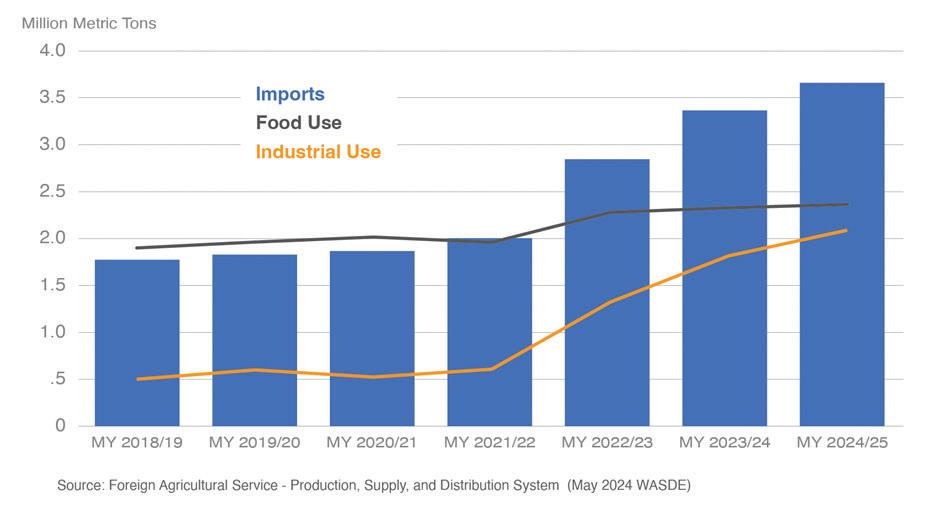
Source: US Department of Agriculture
carbon-intensity biofuels that generate additional credits in the California market.
The boom in renewable diesel production has not only altered traditional import patterns. US agricultural export market dynamics are also experiencing drastic shifts. Firstly, US soyabean exports have trended downward since a record high in 2020/21. While US soyabean exports are forecast higher in 2024/25, the US share of global soyabean trade is expected to remain below the five-year average. The largest force dampening US soyabean exports is greater competition from Brazil, which is forecast to increase its soyabean area for 18 consecutive years in 2024/25. Due to a lack of storage capacity, Brazilian soyabeans sell at a discount to US soyabeans after the South American harvest to ensure supplies are cleared before the following year’s crop. More Brazilian soyabeans means larger supplies competing with US exports during the typical selling window after the US harvest.
soyabean, corn and canola oils. The collective imports of animal fats and vegetable oils have grown drastically in line with the growth of renewable diesel. US import values of all animal fats and vegetable oils more than doubled from 2020 to 2023. One of the major drivers was UCO imports, which more than tripled in 2023 due to higher imports from China (see Figure 3, p32)
US imports of animal fats and vegetable oils should continue to grow in tandem with biomass-based diesel production, but it will get an additional policy bump next year. Starting in January 2025, the federal government will transition from a blender’s credit to a producer’s credit. Therefore, the tax credit will only apply to biomass-based diesel that is produced in the USA. Thus, demand for biofuel imports is expected to drop substantially, driving even greater imports of fats and
oils to US refineries to produce these biofuels domestically. During the past five years (2019-2023), biomass-based diesel imports averaged about onefifth of production volumes, signalling a substantial opportunity for a bump in feedstock demand next year, further boosting a trade deficit that has been rapidly expanding (see Figure 4, p32). Additionally, the Producer’s Tax Credit, coupled with the California LCFS, will heighten demand for lower carbonintensity feedstocks like tallow, UCO and corn oil. Under the LCFS, west-coast market demand is stronger for feedstocks that provide greater carbon-emission reductions than virgin vegetable oils like canola and soyabean oils. These policies will continue to pull available global feedstocks into the California renewable diesel market and boost US import demand for feedstocks that make lower
Source: US Department of Agriculture
Secondly, the decline in US exports is partly due to reduced demand growth in China. The combination of animal disease, slowing economic growth and efforts to reduce soyabean meal usage have dampened Chinese import growth well below average rates during the past two decades. Additionally, economic issues and trade barriers reduced import demand for US soyabeans in Egypt, Pakistan and Bangladesh. These markets collectively represented 10% of US soyabean exports in 2021/22 but fell by 4M tonnes to just a 3% share in 2022/23.
US soyabean oil exports have also been drastically impacted by renewable diesel expansion. The sudden spike in US demand for soyabean oil created a scarcity on the domestic market, pushing the price US buyers were willing to pay well above competitors’ prices in South America. The significant US price premium above South American-origin soyabean oil has rendered US exports uncompetitive.
After the initial renewable diesel boom in 2021, US soyabean oil exports fell by 80% and have not recovered. The drop in exports was so significant that the USA became a net importer of soyabean oil on a tonnage basis in 2023 for the first time. The price discrepancy with South American soyabeans was so great that the USA did not experience an uptick in soyabean oil exports in 2022/23 despite drought slashing production in Argentina, the world’s largest soyabean oil exporter, to its lowest level in more than a decade.
Early this year, US soyabean oil premiums began to narrow, with the

















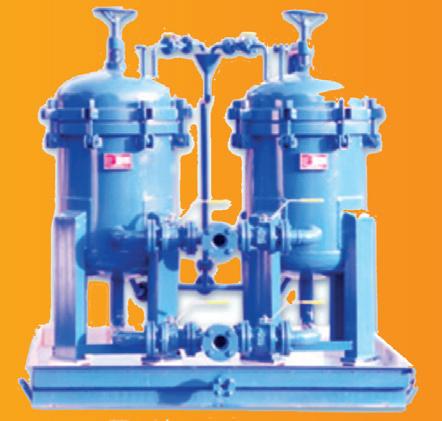










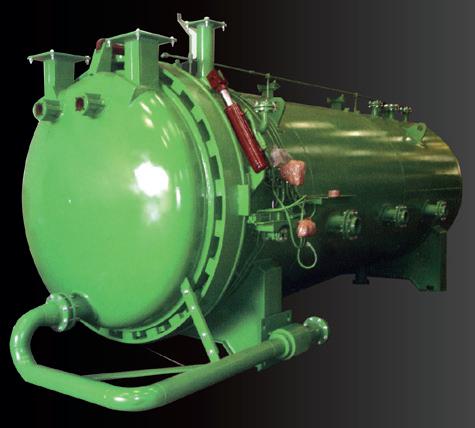
























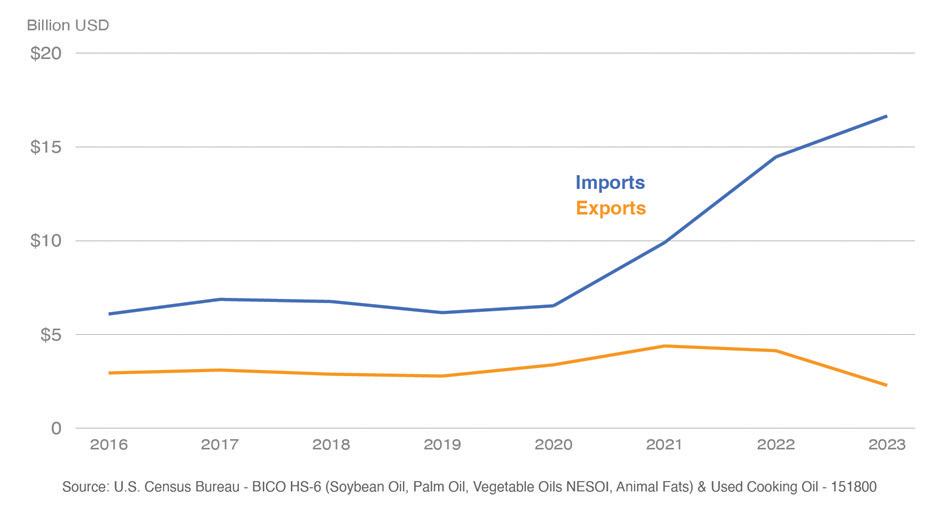
Source: US Census Bureau – BICO HS-6 (soyabean, palm & vegetable oils NESOI, animal fats) and used cooking oil – 151800
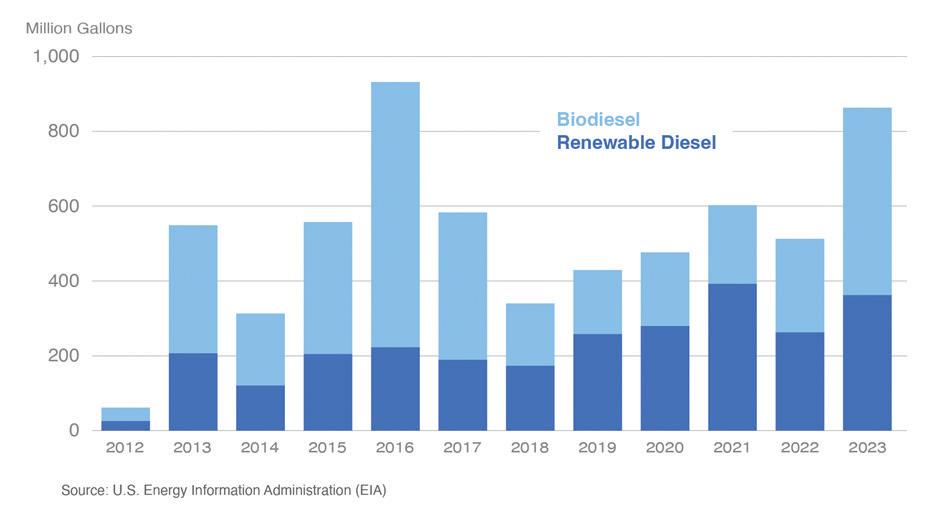
Source: US Energy Information Administration (EIA)
soyabean oil share of renewable diesel feedstocks losing share to tallow and canola oil.
With rising imports of lower carbonintensity feedstocks and lower-cost Canadian canola oil, reliance on soyabean oil for biomass-based diesel production has declined and domestic prices are responding. If price premiums continue to fall, US soyabean oil exports could recover slightly. Forecasted 2024/25 US soyabean oil exports are up marginally but remain well below historic volumes prior to the renewable diesel boom.
In 2024/25, US soyabean crush is forecast at a record for the fourth consecutive year, a direct effect of expanding renewable diesel production elevating domestic soyabean oil prices. Robust growth in US demand for soyabean oil pushing crush higher has led
to greater soyabean meal supplies and record 2022/23 soyabean meal exports. Greater supplies and higher exports are expected to continue in 2024/25.
Since a typical soyabean crush facility produces meal and oil in roughly a 4:1 ratio, the surplus of meal can accumulate rapidly as crush expands for oil. Additionally, soyabean meal has a relatively short shelf-life, so supplies have a limited time frame to be consumed, leading to abundant exportable supplies once local demand is satisfied.
Prior to the renewable diesel expansion, the USA typically accounted for 18% of global soyabean meal exports behind Brazil (25%) and Argentina (40%). However, the USA is expected to grow market share to 21% in 2024/25.
As US soyabean crush and renewable diesel production continue to expand,
the impacts described in this article should mostly become more exaggerated. However, there are a few wildcards that could both heighten or dampen these shifts.
Source: US Department of Agriculture
The main factor driving changes is policy, namely the California LCFS and the US RFS. The expansion of renewable diesel would not have happened without these policy incentives. Therefore, the mandates and incentives created by these policies will determine the rate of production growth in the coming years, which could end up being well below current and proposed capacities at refineries.
Likewise, both imports of animal fats and vegetable oils should further expand, but feedstock availability could limit renewable diesel expansion and slow growth well below proposed capacity expansion.
Coupled with growth in feedstock imports, US soyabean oil exports should continue feeling downward pressure as biomass-based diesel production soaks up domestic supplies and keeps prices less competitive than other suppliers and substitutable vegetable oils.
Source: US Department of Agriculture
Another complex ripple effect from expanding renewable diesel production will be the impact on US soyabean meal production, consumption and trade. During the past year, a large part of the US growth in exports was due to reduced competition from Argentina after the drought. However, when Argentina production recovers to normal levels, it is likely there will not be enough growth in global consumption for both expanding US exports and a recovery in Argentine supplies.
US soyabean crush and renewable diesel growth could be limited by the ability to find an outlet for surplus soyabean meal.
If the USA overproduces soyabean meal, US companies will export excess supplies in the short term rather than letting the product spoil in storage. In order to grow export volumes, US traders will need to drop prices low enough to encourage price-sensitive buyers to switch to US-origin meal.
In the long run, however, if global soyabean meal supplies outpace global consumption and the USA is not able to take market share from Argentina and Brazil, both crush and possibly renewable diesel production will be constrained by an inability to dispose of soyabean meal. ● This article is based on a US Department of Agriculture (USDA) Foreign Agricultural Service (FAS) report ‘Renewable Diesel Production Growth Drastically Impacts Global Feedstock Trade’, published in June 2024
oil
(MOHs) are chemical compounds mainly derived from crude petroleum oil which can end up in food during harvesting and production processes, with mineral oil aromatic hydrocarbon (MOAH) being of concern to human health
Veerle Vanheusden
Mineral oil hydrocarbons (MOH) are chemical compounds derived mainly from crude oil, but also produced synthetically from coal, natural gas and biomass.
There are two main categories of MOHs: MOSH: mineral oil saturated hydrocarbons MOAH: mineral oil aromatic hydrocarbons
MOHs can end up in food during harvesting and production steps, such as during drying processes; contact with exhaust fumes and asphalt; via leaking of machinery lubricants; or from mineral oil containing anti-dusting agents or nonstick agents. They can also enter food via contaminated extraction solvents; from contamination during the recuperation process for extraction solvents; via contaminated food ingredients, food additives or food contact materials; and through environmental contamination.
Most sources of MOHs in food are avoidable by following good practices at all stages of production.
The first EU risk assessment of MOHs in food was carried out in 2012 by the European Food Safety Authority (EFSA), which concluded that exposure to MOSH and MOAH in food was of potential concern.
EFSA said MOSH could accumulate in human tissue and could cause adverse effects in the liver, and that MOAH may be mutagenic and carcinogenic.
At that time, there was insufficient occurrence data to set maximum levels for MOHs in food so the European Commission (EC) issued a recommendation in 2017 to collect further occurrence data. In 2020, the EC mandated EFSA to update its risk assessment of MOHs in food.
In 2019 and 2021, NGO Foodwatch carried out a survey of various foods and
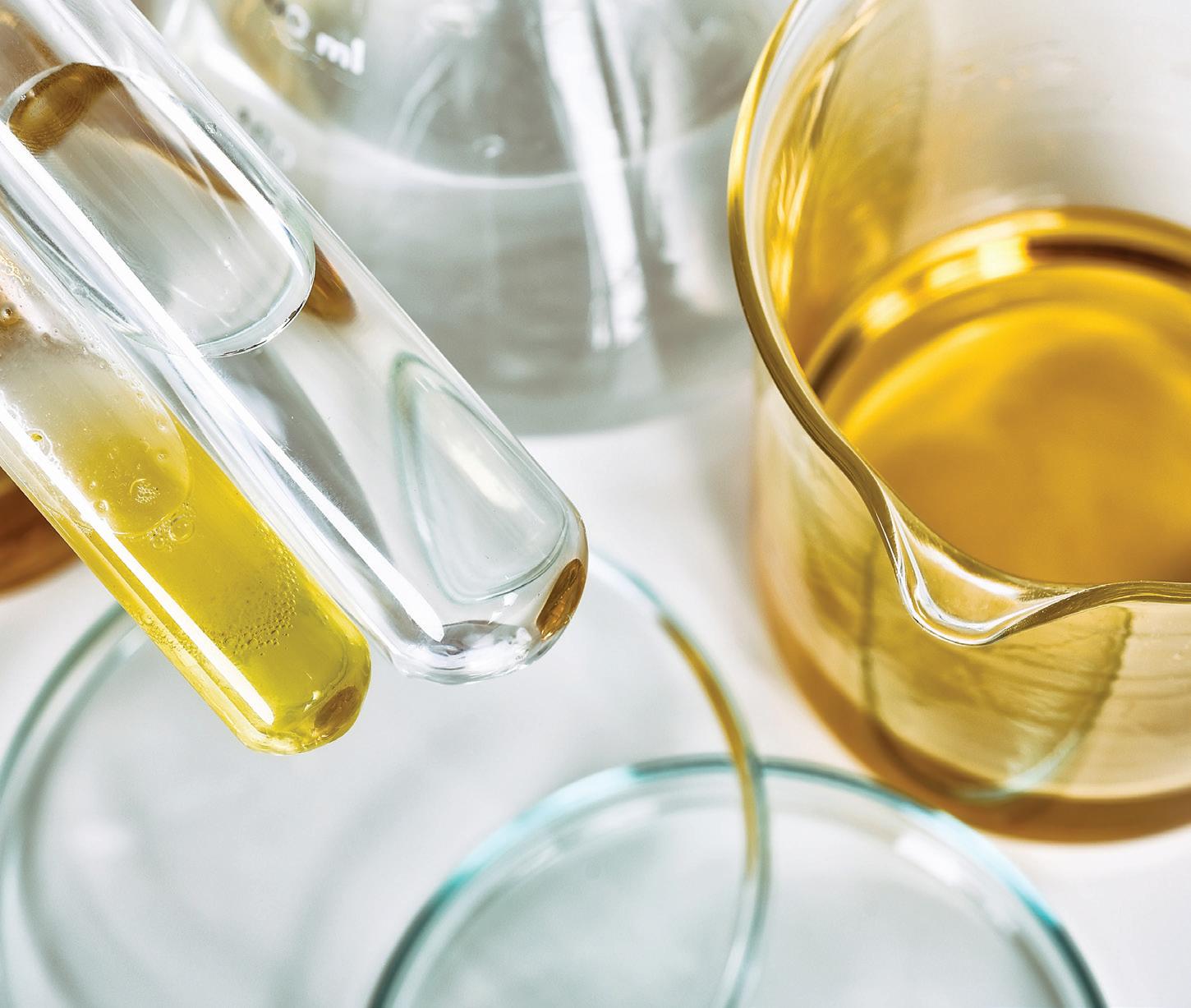
found a wide range of concentrations of MOAH in food products, including in infant and follow-on formula.
Following these findings, EU member states agreed that pending the establishment of maximum levels (MLs) for MOAH in food, a common enforcement approach was appropriate.
EU member states agreed that good practices existed to avoid the presence of MOAH in food so that no MOAH should be present in food at levels above the limit of quantification (LOQ) – the lowest concentration of a substance that can be reliably detected and quantified with known accuracy and precision.
While awaiting the establishment of MLs for MOAH in food, EU member states agreed that enforcement action should be made on the basis of Article 14 of the General Food Law (GFL), which states that food should not be placed on the market if it is unsafe.
In a 21 April 2022 joint statement on the presence of MOAH in food, including food for infants and young children, EU member states said that in order to ensure a uniform enforcement approach throughout the EU, they agreed to withdraw and, if necessary, recall products from the market when the sum of the concentrations of MOAH in food were at. or above, the following maximum LOQs:
• 0.5mg/kg for dry foods with a low fat/ oil content (≤ 4% fat/oil)
• 1mg/kg for foods with a higher fat/oil content (>4% fat/oil, ≤50% fat/oil)
• 2mg/kg for fats/oils or foods with >50% fat/oil
Risk assessment of MOHs in food
In 2023, EFSA issued an update on its risk assessment of MOHs in food. It concluded that current dietary exposure to MOSH does not raise a concern for human health. However, because MOSH accumulates in various organs in the body, the margin for safe exposure is very limited and its conclusion might change if mitigation measures are dropped.
ESFA concluded that 3-7 ring MOAHs contained genotoxic carcinogens.
For 1-2 ring MOAH, while some studies pointed towards mutagenic and carcinogenic effects, there was insufficient high quality toxicological information available to allow a conclusive risk assessment.
Taking into account these factors, ESFA concluded that the occurrence of total MOAH in food was of concern for human health.
In its 2023 EFSA opinion, ESFA made various recommendations to collect further data such as improving analytical methods, further investigating the sources
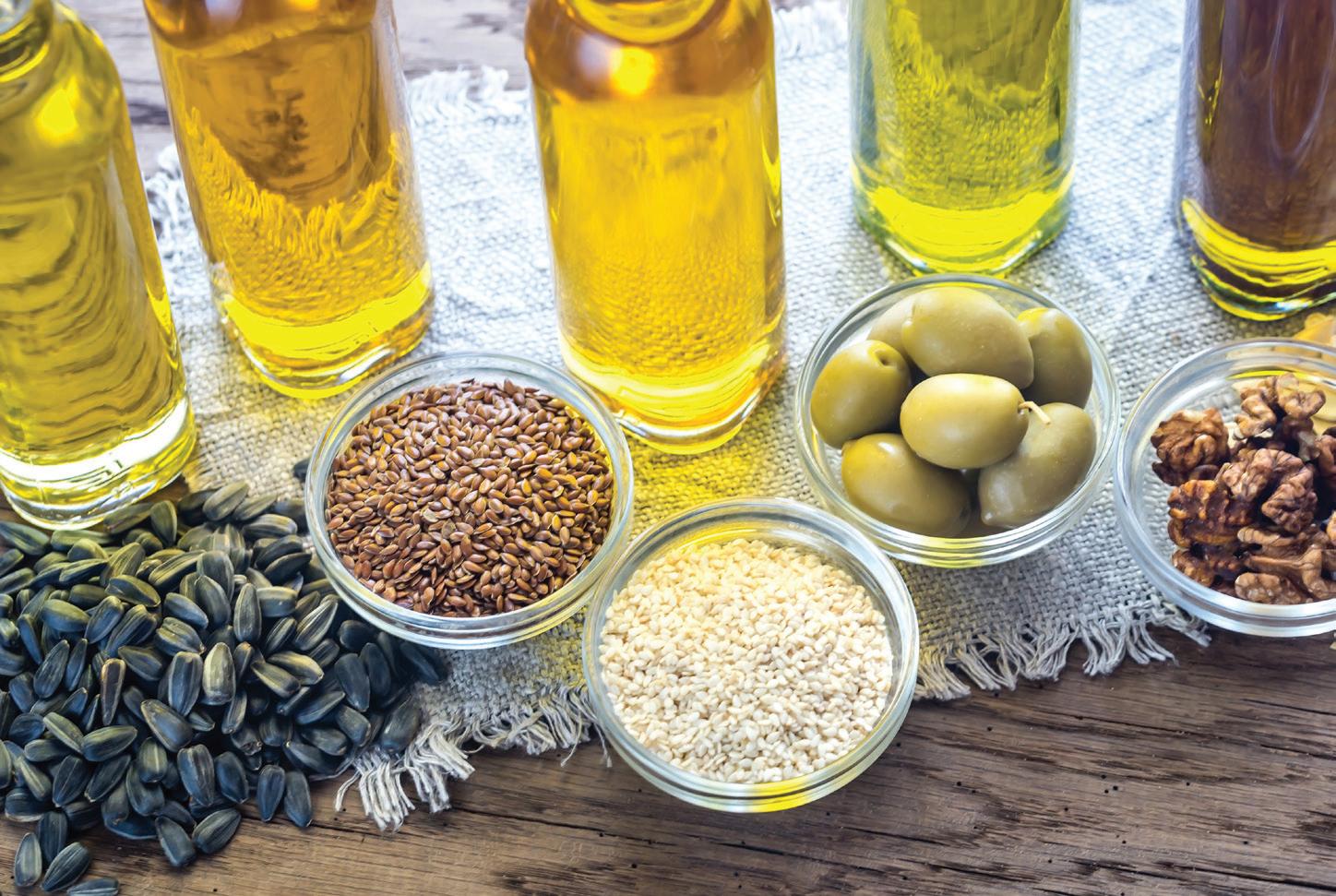
of the contamination, and collecting more toxicological, toxicokinetic and occurrence data.
It also recommended establishing a specification for MOAH in food additives and food contact materials.
The 2023 ESFA opinion concluded that MOAH in food was of concern for human health risks, mandating the EC to establish maximum levels for MOAH in food.
Under the EU regulatory framework on contaminants in food (Council Regulation EEC No 315/93), food containing a contaminant in an amount which is unacceptable from the public health viewpoint shall not be placed on the market. Contaminant levels have to be kept as low as can reasonably be achieved (the ALARA principle) by following good practices at all production stages.
In order to protect public health, the EC may, where necessary, establish maximum levels for certain contaminants in certain foods. These maximum levels are then established under Commission Regulation (EU) 2023/915. These maximum levels should be established in accordance with the ALARA principle.
There are currently three EU regulations following up on the 2023 EFSA opinion.
• A draft regulation on maximum levels (MLs) for MOAH in food.
• A draft recommendation on the monitoring of MOHs in food.
• A draft regulation on methods for the sampling and analysis of MOHs in food. The EC intends to set MLs for foods
that are relevant contributors to MOAH exposure and for foods that may contain very high concentrations of MOAH. MOAH is mostly found in processed foods due to contamination during processing, transport and packaging. Concentrations are low in fresh foods, which will not be included in the scope of the draft regulation.
Commodities and basic ingredients in which MLs will be set are: oilseeds and oil fruits; animal and vegetable fats and oils; tree nuts; pulses; cereal grains; milk; cocoa beans; sugar; spices and dried herbs.
For dried, diluted, processed and compound foods, the ML will be calculated in accordance with Article 3 of Regulation (EU) 2023/915. This means that the maximum level for the final product is calculated based on the MLs for the ingredients and ingredient composition, taking into account concentration or dilution factors.
For compound foods, the maximum level for the final product may be unrealistically low and impossible to achieve analytically due to some ingredients not having an ML (resulting in a zero ML).
In this case, provisions have been added where if there is no maximum level for MOAH, the following concentrations should be taken into account for calculating the maximum level for the compound food:
• 0.5g/kg for ingredients with a fat <4% fat/oil content
• 1.0mg/kg for ingredients with ≥4% and ≤50% fat/oil content
• 2.0 mg/kg for ingredients with >50% fat/oil content.
This is to ensure that the calculated amount for the final food is analytically achievable.
For establishing MLs for MOAH in food under the ALARA principle, it can be seen that 90-95% of all food contain MOAH concentrations below the achievable limits of quantification (LOQs).
This means that when good practices are used, concentrations of MOAH in food can be kept below the LOQ.
Therefore, the initially discussed MLs for MOAH were proposed at achievable LOQs, ie 0.5-2.0mg/kg depending on the fat content of the product.
An important point to note is that when deciding on the compliance of a product, the measurement uncertainty should be taken into account. This is to be entirely sure that when a product is said to be non-compliant, it really is non-compliant.
Those conducting analyses need to deduct the measurement uncertainty from the analytical result. Only when the result of that subtraction is above the ML should a product be non-compliant.
Analytical result: MU should be ≤ ML
EU stakeholders from the food industry were consulted at the start of this year on the ML at the limit of quantification (LOQ). They submitted comments and occurrence data which showed that for many foods, the bulk of production complied with an ML at the LOQ. However, for some products, the bulk of production did not yet comply with an ML of 0.50-2.0mg/kg. For a limited number of products, the LOQ of 0.50-2.0mg/kg could not be achieved due to endogenous interfering substances.
Following on from the stakeholders’ comments and data, a revised draft proposal has been drawn up in accordance with the ALARA principle.
This version contains MLs at the LOQ for those commodities in which this is achievable.
For certain commodities for which an ML at the LOQ is not yet achievable, a time plan is included which starts with higher MLs, to be reduced over time to the LOQ in order to give food business operators more time to implement the appropriate mitigation measures.
For products for which a LOQ above 2.0 mg/kg is not achievable, due to endogenous interfering substances, a higher ML is proposed.
Furthermore, EU member states are discussing transitional measures for products placed on the market before the application date. They are also discussing what would be the appropriate application date of the MLs.
In mid-2024, the EC published a frequently asked questions document answering general stakeholder comments and questions. For the remainder of 2024, discussions with member states will continue on the proposed MLs and transitional measures.
Between the first and third quarter of 2025, stakeholders will be informed on how their comments on specific MLs were taken into account.
The EU proposal will also be notified to the World Trade Organization (WTO) so that third countries can comment on its proposal.
A vote on the proposal will be scheduled at the WTO Standing Committee on Plants, Animals, Food and Feed and if a favourable vote is reached, the regulatory procedure for scrutiny by the European Parliament and Council will be launched and adoption procedures will take place. These procedures will take about four months, meaning that the targeted entry for the regulation to come into force is the end of 2025.
It is very important to note that in the period before the application date of maximum levels, the ESFA statement of members states (21 April 2022) on the enforcement of quantities of MOAH above the LOQ will remain valid. Member states will need to keep enforcing levels of MOAH in food above the limit of quantification.
Alongside the draft regulation on maximum levels (MLs) for MOAH in food, there is also a draft regulation under discussion which focuses on the gathering of MOH occurrence data, the carrying out of investigations towards the sources of contamination, and on the application of MOH mitigation measures.
There are also recommendations to develop more sensitive analytical methods.
The monitoring recommendation establishes indicative levels (ILs) for MOHs in food. These are levels that, once exceeded, should result in an investigation into the sources of the contamination and the application of mitigation measures to avoid future contaminations.
ILs should not be used as a threshold for removing products from the market’ and ILs for MOSH in food are proposed between 0.50-15mg/kg, depending on the commodity.
ILs for MOAH in food are proposed for some commodities from which beverages are prepared. As MOAH only transfers to
Parameter
Applicability
Specificity
Recovery
Within-laboratory reproducibility (intermediate precision) (RSDR)
Food with a fat content <4%
Within-laboratory reproducibility (RSDR)
Food with a fat content >=4% LOQ
Food with a fat content of <4% LOQ
Food with a fat content of 4-50% LOQ
Food with a fat content of >50%
to beverages to a limited extent, no MLs were established for these commodities: coffee beans, tea and herbal infusions, cereal grains used for the production of beer or distillates provided that the remaining cereal residue is not placed on the market for the final consumer as food.
Because contaminations can occur in certain processed foods, but occurrence data is lacking to establish MLs at this stage, ILs are also proposed for processed vegetables, processed fruits, processed meat and offal, processed fish and other seafood, and processed eggs.
The third piece of legislation to tackle MOHs is a draft regulation on methods to sample and analyse MOAH in food.
This will be an amendment to Regulation (EC) No 333/2007, with specific sampling and analytical method requirements for MOHs.
Some specific requirements for MOHs are added to the regulation – these are precautions to be taken to avoid contamination during the sampling and analysis procedures.
There are also specific analytical method requirements for MOHs in food. (see Table 1, above).
Discussions are also ongoing to establish specifications for MOAH in food additives and food contact materials, with the DG SANTE teams on food contact materials and food additives due to start discussions on the MOAH content of white mineral oils and waxes used as food additives and food packaging materials.
Criterion
Food specified in Regulation (EC) No 915/2023
Free from matrix or spectral interferences
80-110% (The recovery can be lower than 80%, when applying a sample preparation with aluminium oxyde for the determination of mineral oil saturated hydrocarbons or when permorming a sample preparation with epoxidation for the analysis of mineral oil aromatic hydrocarbons)
≤15%
≤20%
≤0.50mg/kg
≤1.0mg/kg
≤2.0mg/kg
It is very important that food business operators take action to avoid the presence of MOHs in food. They should:
• Monitor the production process to avoid the contamination of food at all stages of production and transport, including through packaging.
• They should check their drying processes and avoid contact with asphalt, burning fumes, and exhaust fumes of machinery.
• Use food grade lubricants.
• Use MOH-free food contact materials or ensure that no transfer of MOH to the food is possible by using MOH-free jute bags or MOH-free wrappers.
• Use MOH-free ingredients and food additives.
• Use MOH-free hexane and replace paraffin columns for hexane recuperation in extraction processes. Alternatives are refined or semi-refined plant-based oils or synthetic MOH-free waxes.
FoodDrinkEurope has published a toolbox which operators can use to prevent the transfer of undesired mineral oil hydrocarbons into food.
Finally, it is very important that food business operators check their final food and food contact materials for unexpected sources of contamination during their process.
● This article is based on a presentation made by Veerle Vanheusden, Policy officer – Unit E2 – Food processing and novel food, Directorate General Health and Food Safety, European Commission, at OFI International 2024 on 9-11 September
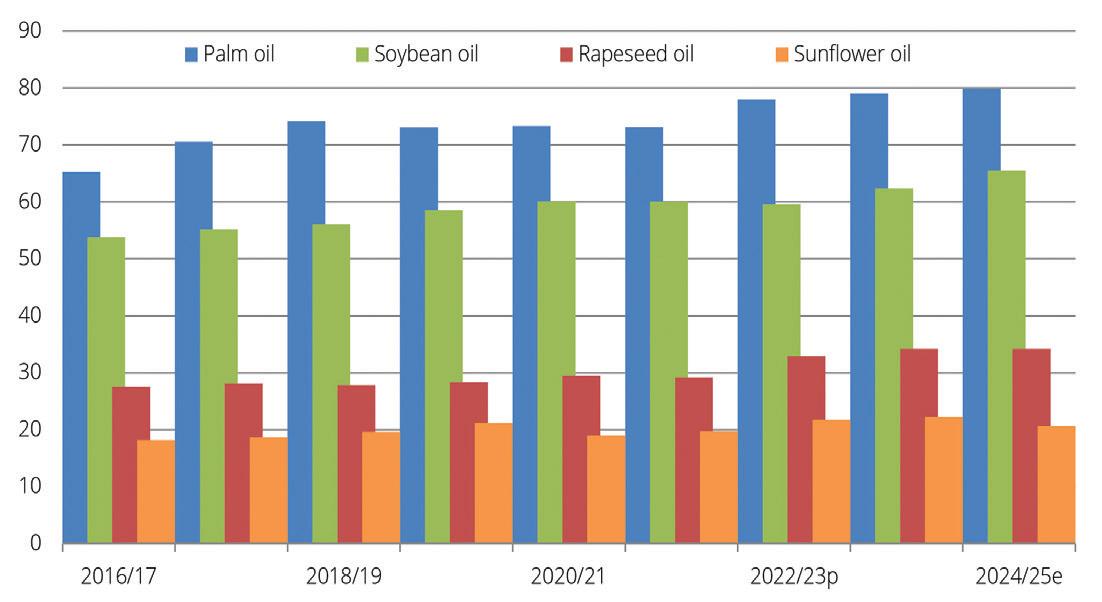
p = preliminary e = estimated
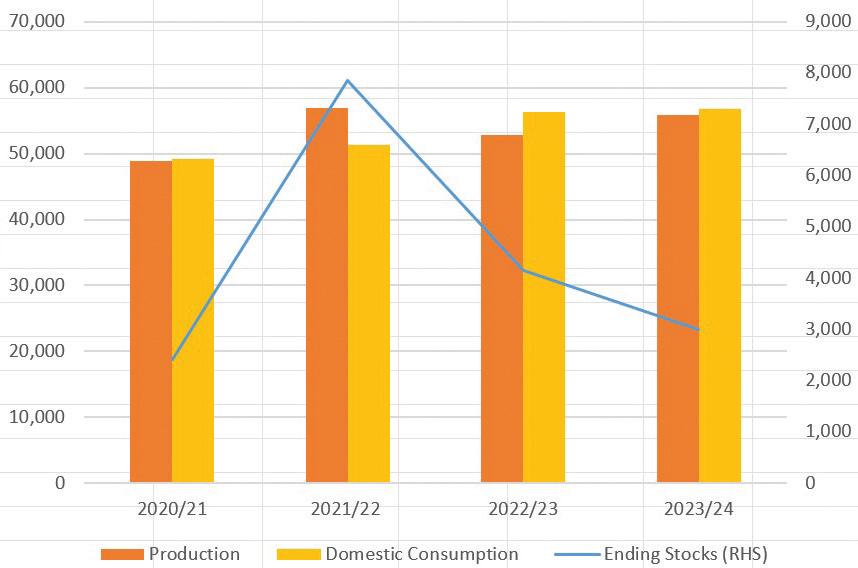

The US Department of Agriculture (USDA) expects global production of vegetable oils in the current crop year to hit a record level of 224.2M tonnes, a 2.7M tonne rise year-on-year, the Union zur Förderung von Oel- und Proteinpflanzen (UFOP) reports. Consumption is estimated at 221.7M tonnes, up 5.3M tonnes on the previous year. According to Agrarmarkt Informations-Gesellschaft, palm oil production is set to reach a record volume in 2024/25, forecast by the USDA at 79.8M tonnes, up 0.8M tonnes on 2023/24. Soyabean oil production is also likely to hit a new record of 65.5M tonnes. Production of rapeseed oil is set to reach a record high of 34.2M tonnes.
However, the USDA expects sunflower oil production to plummet in 2024/25, especially due to a more than 1M tonne decline in production in Ukraine.
The Expana Benchmark Prices (EBP) for sunflower oil FOB NW Europe was assessed at US$1,155.50/tonne on 9 October, up by 4.5% week-on-week and by 10.6% month-on-month. The increase in the EBP is attributable to supply concerns across key producers – Ukraine, Russia and the EU.
Market sources in Ukraine report that a limited supply of sunflowerseeds from farmers, combined with rising prices for both the seed and sunflower oil, is causing instability in the market. Processing plants are being forced to operate at reduced capacity to keep operations running. Faced with these challenges, some plants have shifted to processing soyabeans, which currently provide more price stability and more attractive profit margins. This move has become a viable option for maintaining profitability amid the current difficulties in the sunflowerseed market.
Meanwhile, In Russia, sunflowerseed and oil prices are also trending upward due to a smaller-than-expected harvest, with early reports indicating that production for the 2024/25 season could fall to around 15M tonnes from 16.5M tonnes in the 2023/24 season. This supply shortfall, coupled with rising demand for oil, is expected to further elevate sunflowerseed prices. A key concern highlighted by the majority of Expana’s sources is the sub-par oil content of the seeds. Many are failing to meet the standard 44-48% oil content, with some batches even falling below 40%, market participants noted.
For the 2024/25 season, the USDA estimated global sunflowerseed production at 50.5M tonnes, down by 9.6% compared to the previous season. Similarly, global sunflowerseed oil production is projected to decline year-on-year by 10.5%.

Expana provides independent insight and data to help companies make informed commercial decisions.
Tel: +44 (0)1628 851313
E-mail: sales@Expanamarkets.com Website: www.Expanamarkets.com


